2020-10-22 - Nº 286
Editorial
Esta é a Newsletter Nº 286 que se apresenta com o mesmo formato que as anteriores. Se gostar da Newsletter partilhe-a!
Todas as Newsletters encontram-se indexadas no link.
Esta Newsletter tem os seguintes tópicos:
Faz hoje anos que nascia, em 1881, o físico norte-americano Clinton Davisson. Ele dividiu o Prémio Nobel de Física em 1937 (com o inglês George P. Thomson) por descobrir que os electrões podem ser difractados como ondas de luz, verificando assim a tese de Louis de Broglie de que os electrões comportam-se tanto como ondas assim como partículas. Davisson estudou o efeito do bombardeamento de electrões em superfícies e observou que o ângulo de reflexão pode depender da orientação do cristal. Seguindo a teoria de Louis de Broglie da natureza ondulatória das partículas, ele percebeu que os seus resultados poderiam ser devidos à difracção de electrões pelo padrão dos átomos na superfície do cristal. Davisson trabalhou com Lester Germer numa experiência na qual electrões ricocheteando numa superfície de níquel produziram padrões de onda semelhantes aos formados pela luz reflectida numa rede de difracção e apoiando o comprimento de onda do electrão de Broglie. Esta descoberta foi aplicada ao estudo da estrutura nuclear, atómica e molecular. Davisson ajudou a desenvolver o microscópio electrónico que usa a natureza de onda dos electrões para ver detalhes mais pequenos que o comprimento de onda da luz visível.
Faz também hoje anos que nascia, em 1902, o químico norte-americano Frank Spedding. Ele desenvolveu processos de redução de elementos individuais de terras raras ao estado metálico a baixo custo, tornando assim essas substâncias disponíveis para a indústria a preços razoáveis. Anteriormente, após a descoberta da fissão nuclear em 1939, o governo dos Estados Unidos pediu aos principais cientistas que se unissem ao desenvolvimento da energia nuclear. Em 1942, Frank H. Spedding do Iowa State College, um especialista em química de terras raras, concordou em estabelecer a parte Ames do Projecto Manhattan, tendo como resultado um procedimento fácil e barato para produzir urânio de alta qualidade.
Por fim, faz hoje anos que nascia, em 1905, o engenheiro electrotécnico norte-american Karl Guthe Jansky. Ele descobriu as emissões de rádio cósmicas em 1932. Nos laboratórios Bell em NJ, Jansky estava a seguir os ruídos crepitantes de estática que atormentavam a recepção de telefone no exterior. Ele descobriu que certas ondas de rádio vinham de uma região específica do céu a cada 23 horas e 56 minutos, da direcção de Sagitário em direcção ao centro da Via Láctea. Na publicação do seus resultados, ele sugeriu que a emissão de rádio estava de alguma forma ligada à Via Láctea e que provinha não de estrelas, mas de gás interestelar ionizado. Aos 26 anos, Jansky fez uma descoberta histórica - que os corpos celestes podiam emitir ondas de rádio assim como ondas de luz.
Foi a 22 de Outubro de 1879 que a longa série de experiências de Edison a testar materiais como filamento de luz eléctrica chegou a um ponto crítico. Charles Batchelor, a trabalhar no laboratório de Edison em Menlo Park, produziu iluminação durante 14 horas e meia a partir de uma lâmpada usando um fio de algodão carbonizado. Ela falhou quando foi adicionada energia extra. No entanto, esta foi uma melhoria tão substancial, que a atenção se voltou para melhorar o filamento carbonizado. As patentes foram registadas e, em dois meses, o progresso com a lâmpada Edison foi tornado público. Um artigo foi publicado em 21 de Dezembro pelo New York Herald. Nessa altura, o laboratório de Menlo Park estava permanentemente iluminado pelas lâmpadas incandescentes de Edison.
Nesta semana que passou foi lançada a versão 20.10 da Distro de Linux Ubuntu. Esta Distro é criada pela Canonical e esta versão tem como principais novidades o GNOME 3.38, o Kernel Linux 5.8, o GCC 10 e o Python 3.8. Esta é a primeira versão que suporta oficialmente o Raspberry PI 4.
Também nesta semana que passou a sonda OSIRIS-REx entrou em contacto com o asteróide Bennu e fez recolha de amostras. Este momento foi muito celebrado uma vez que este é o quarto ano desta missão e este é um ponto crucial da mesma. A sonda agora deverá regressar à Terra e chegar daqui a três anos, em 2023.
Nesta semana foi também apresentada pela fundação Raspberry PI a versão SOM (system-on-module) do Raspberry PI 4. Esta versão apresenta uma grande novidade relativamente às anteriores - deixou de usar os conectores do tipo JEDEC DDR2 e passou a usar um conector de alta densidade. Construído com o mesmo processador BCM2711 quad-core de 64 bits do Raspberry Pi 4, o novo Compute Module 4 oferece uma mudança radical no desempenho em relação aos seus predecessores: núcleos de CPU mais rápidos, melhor multimédia, mais recursos de interface e, pela primeira vez, uma escolha de capacidade de RAM e uma opção de conectividade Wifi. Existem 32 variantes de onde escolher, entre as varias opções de RAM, storage eMMC e Wifi. A placa de Módulos de I/O onde se encaixa a nova SOM tem suporte para dois HDMI, Gigabit Ethernet, uma PCI Express Gen2, RTC com bateria e duas Portas USB 2.0.
Na Newsletter desta semana apresentamos diversas noticias, artigos científicos assim como projetos de maker. É apresentada a revista Hackspace Magazine Nº36 de Novembro.
 João Alves ([email protected])
João Alves ([email protected])
O conteúdo da Newsletter encontra-se sob a licença  Creative Commons Attribution-NonCommercial-ShareAlike 4.0 International License.
Creative Commons Attribution-NonCommercial-ShareAlike 4.0 International License.
Novidades da Semana

Canonical Officially Launches Ubuntu 20.10
"Ubuntu was, is, and will probably remain the leading Linux distribution out there, at least as far as the number of users is considered. And the one to thank is Canonical’s commitment to keeping Ubuntu up-to-date with the latest technologies, features, and apps out there, so the frequent OS updates that the company releases brings its platform in line with the rest of the market. Ubuntu 20.10 is the newest release that went live this week, and this time, there are massive improvements coming to users. The most important of them is the release of optimized Raspberry Pi images for desktop and servers, which according to the company, should come in handy to “learners, inventors, educators, and entrepreneurs.” While support for the Raspberry Pi has been around for a while, this is the first release that adds the pocket-size computers to the list of devices certified with Ubuntu. “In this release, we celebrate the Raspberry Pi Foundation’s commitment to put open computing in the hands of people all over the world,” said Mark Shuttleworth, CEO at Canonical. “We are honoured to support that initiative by optimising Ubuntu on the Raspberry Pi, whether for personal use, educational purposes or as a foundation for their next business venture.” All latest Raspberry Pi models are now certified with Ubuntu, as long as they come with 4GB or 8GB RAM." [...]

NASA’s OSIRIS-REx Spacecraft Successfully Touches Asteroid
"NASA’s Origins, Spectral Interpretation, Resource Identification, Security, Regolith Explorer (OSIRIS-REx) spacecraft unfurled its robotic arm Tuesday, and in a first for the agency, briefly touched an asteroid to collect dust and pebbles from the surface for delivery to Earth in 2023. This well-preserved, ancient asteroid, known as Bennu, is currently more than 200 million miles (321 million kilometers) from Earth. Bennu offers scientists a window into the early solar system as it was first taking shape billions of years ago and flinging ingredients that could have helped seed life on Earth. If Tuesday’s sample collection event, known as “Touch-And-Go” (TAG), provided enough of a sample, mission teams will command the spacecraft to begin stowing the precious primordial cargo to begin its journey back to Earth in March 2021. Otherwise, they will prepare for another attempt in January. “This amazing first for NASA demonstrates how an incredible team from across the country came together and persevered through incredible challenges to expand the boundaries of knowledge,” said NASA Administrator Jim Bridenstine." [...]
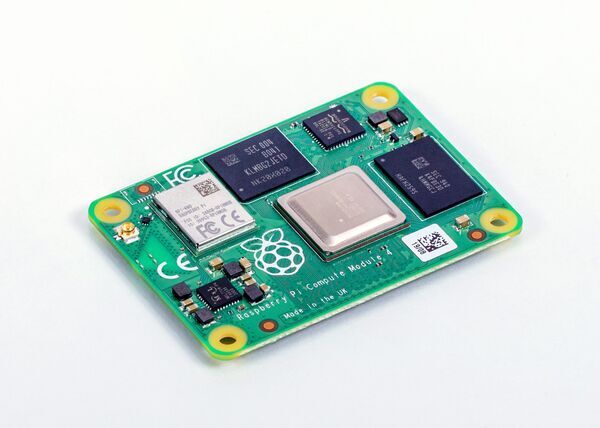
Raspberry Pi Compute Module 4 on sale now from $25
"It’s become a tradition that we follow each Raspberry Pi model with a system-on-module variant based on the same core silicon. Raspberry Pi 1 gave rise to the original Compute Module in 2014; Raspberry Pi 3 and 3+ were followed by Compute Module 3 and 3+ in 2017 and 2019 respectively. Only Raspberry Pi 2, our shortest-lived flagship product at just thirteen months, escaped the Compute Module treatment. It’s been sixteen months since we unleashed Raspberry Pi 4 on the world, and today we’re announcing the launch of Compute Module 4, starting from $25. Over half of the seven million Raspberry Pi units we sell each year go into industrial and commercial applications, from digital signage to thin clients to process automation. Many of these applications use the familiar single-board Raspberry Pi, but for users who want a more compact or custom form factor, or on-board eMMC storage, Compute Module products provide a simple way to move from a Raspberry Pi-based prototype to volume production." [...]
Outras Notícias

SK hynix to Acquire Intel NAND Memory Business
"SK hynix and Intel today announced that they have signed an agreement on Oct. 20, KST, under which SK hynix would acquire Intel’s NAND memory and storage business for US $9 billion. The transaction includes the NAND SSD business, the NAND component and wafer business, and the Dalian NAND memory manufacturing facility in China. Intel will retain its distinct Intel® OptaneTM business. SK hynix and Intel will endeavor to obtain required governmental approvals expected in late 2021. Following receipt of these approvals, SK hynix will acquire from Intel the NAND SSD business (including NAND SSD-associated IP and employees), as well as the Dalian facility, with the first payment of US $7 billion. SK hynix will acquire from Intel the remaining assets, including IP related to the manufacture and design of NAND flash wafers, R&D employees, and the Dalian fab workforce, upon a final closing, expected to occur in March 2025 with the remaining payment of US $2 billion." [...]
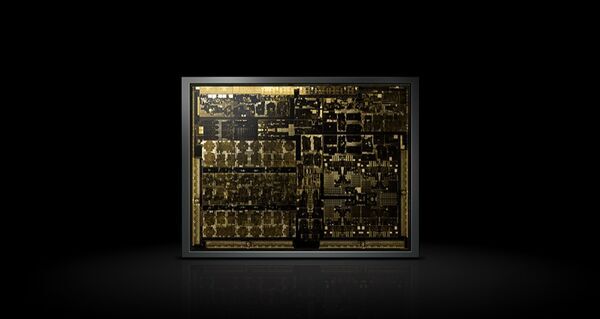
NVIDIA Xavier Shatters Records, Excels in Back-to-Back Performance Benchmarks
"The brain of the DRIVE AGX platform for autonomous vehicles dominates MLPerf inference tests for the second year in a row. AI-powered vehicles aren’t a future vision, they’re a reality today. And they’re only truly possible on NVIDIA Xavier, our system-on-a-chip for autonomous vehicles. The key to these cutting-edge vehicles is inference — the process of running AI models in real time to extract insights from enormous amounts of data. And when it comes to in-vehicle inference, NVIDIA Xavier has been proven the best — and the only — platform capable of real-world AI processing, yet again. NVIDIA GPUs smashed performance records across AI inference in data center and edge computing systems in the latest round of MLPerf benchmarks, the only consortium-based and peer-reviewed inference performance tests." [...]
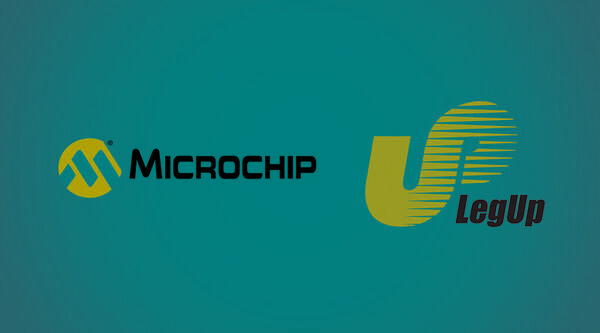
Microchip Acquires High-Level Synthesis Tool Provider LegUp to Simplify Development of PolarFire FPGA-based Edge Compute Solutions
"Software engineers can now map applications coded in C/C++ directly into PolarFire FPGAs and SoCs that are the industry’s lowest-power mid-range fabric solutions for acceleration Microchip Technology Inc. (Nasdaq: MCHP) today announced it acquired Toronto-based LegUp Computing Inc., expanding its Field-Programmable Gate Array (FPGA)-based edge compute solution stack with a high-level synthesis (HLS) tool. Commercialized from University of Toronto research, the LegUp HLS tool will make it easier for a larger community of software engineers to harness the algorithm-accelerating power of Microchip’s PolarFire® FPGA and PolarFire System on Chip (SoC) platforms. “The LegUp team brings us deep experience in high-level synthesis and related technologies as we continue to optimize the integrated design environment tool flows for our PolarFire FPGA and PolarFire SoC customers,” said Bruce Weyer, vice president of the FPGA business unit at Microchip. “The acquisition also gives our traditional Microchip MCU and MPU clients the ability to use FPGAs as accelerators through an easy-to-use compiler that will substantially improve their design productivity and system performance while shortening their time to market.” The LegUp HLS tool will be used alongside Microchip’s VectorBlox Accelerator Software Design kit and VectorBlox Neural Networking IP generator to provide a complete front-end solution stack for C/C++ algorithm developers who want to work with PolarFire FPGA and PolarFire SoC devices without having to understand the underlying Register Transfer Level (RTL) development flows. Microchip acquired Vancouver, Canada-based VectorBlox Computing in August 2019 to enhance its portfolio of solutions for edge compute applications. “Software engineers needing hardware acceleration demand performance and power efficiency, while looking for tools that enable higher levels of abstraction for the hardware that will implement their compute-intensive algorithms,” said Andrew Canis, CEO of LegUp Computing, now part of Microchip." [...]

Latest NPU adds to Arm’s AI Platform performance, applicability, and efficiency
"With an ever-increasing range of devices adding artificial intelligence (AI) functionality, Arm today announced the latest member of its Ethos product line, the Arm Ethos-U65 microNPU (Neural Processing Unit). Focused on AI/machine learning (ML) processing, and providing a new performance point and new capabilities, the Ethos-U65 maintains the power efficiency of the Arm Ethos-U55 while extending its applicability from Arm Cortex-M to Arm Cortex-A and Arm Neoverse-based systems, and at the same time delivering twice the on-device ML performance. The rapid adoption of AI and ML into edge and endpoint devices is driving not only increased functionality but also increased device and system requirements. This in turn means providers must deliver systems with more performance and on-device ML capabilities, while maintaining or improving power efficiency. Enabling AI everywhere: No device left behind Arm’s unparalleled AI platform is designed to deliver flexible, scalable technologies to the broadest range of devices. Earlier this year we announced new ML IP, the Arm Cortex-M55 processor and Arm Ethos-U55, the world’s first microNPU, a combined solution delivering a 480x leap in ML performance for microcontrollers." [...]
Toshiba Launches 1200V Silicon Carbide MOSFET that Contributes to High-efficiency Power Supply
"Toshiba Electronic Devices & Storage Corporation (“Toshiba”) has launched “TW070J120B,” a 1200V silicon carbide (SiC) MOSFET for industrial applications that include large capacity power supply. Shipments start today. The power MOSFET using the SiC, a new material, achieves high voltage resistance, high-speed switching, and low On-resistance compared to conventional silicon (Si) MOSFET, IGBT products. Therefore, it will contribute to lower power consumption and system downsizing. Fabricated with Toshiba’s second-generation chip design[1], which improves the reliability of SiC MOSFET, the new device realizes low input capacitance, a low gate-input charge, and low drain-to-source On-resistance. Compared with “GT40QR21,” Toshiba’s 1200V silicon insulated gate bipolar transistor (IGBT), it cuts turn-off switching loss by about 80% and switching time (fall time) by about 70%, while delivering low On-voltage characteristics with a drain current of 20A or less[2]." [...]

STMicroelectronics Eases Access to STM32WB Dual-Core Wireless MCUs for Bluetooth® LE 5.0, Zigbee® 3.0, and Thread Connectivity
"STMicroelectronics has expanded the STM32WB portfolio of dual-core multi-protocol microcontrollers (MCUs) by introducing the STM32WB35 and STM32WB30 Value Line, giving designers more flexibility to target cost-conscious market opportunities. The extremely low-power MCUs integrate a 2.4GHz radio managed by a dedicated Arm® Cortex®-M0+ core, with a 64MHz Arm® Cortex-M4 for the main application, to permit uninterrupted real-time performance. They support Bluetooth® Low Energy 5.0, Zigbee® 3.0, OpenThread (IEEE 802.15.4) protocols and concurrent modes, with built-in security features. All stacks are fully certified, supported and handled by ST and available free of charge. The new devices are suited to large-scale IoT applications such as fleet and resource management, as well as asset monitoring and tracking. Packaged in QFN48, the new devices are pin compatible with existing STM32WB5x devices and share common MCU features, giving users flexibility to easily scale and migrate their designs." [...]

‘World’s first’ MIDI over Bluetooth LE wireless adaptor allows user to play any MIDI instruments without the need for cables
"QUICCO SOUND’s mi.1 Cable and mi.1 II employ Nordic nRF52832 SoC-based Insight SiP module for MIDI over Bluetooth LE connectivity between instruments, equipment and apps Nordic Semiconductor today announces that Hamamatsu, Japan-based QUICCO SOUND, has selected an Insight SiP module integrating Nordic’s nRF52832 Bluetooth® Low Energy (Bluetooth LE) System-on-Chip (SoC), to power its ‘mi.1 Cable’ and ‘Mi.1 II’. The mi.1 Cable wirelessly connects two MIDI instruments, while the Mi.1 II is used to wirelessly connect a MIDI instrument to a smartphone. MIDI (Musical Instrument Digital Interface) is a technical standard that describes a communications protocol, digital interface, and electrical connectors that connect a wide variety of electronic musical instruments, computers, and related audio devices for playing, editing and recording music. Designed to replace a traditional wired MIDI cable, the mi.1 Cable is said to be the world’s first Bluetooth MIDI pair of wireless adaptors that does not require a separate battery to operate because its low power consumption enables it to take its power directly from the small amount of current flowing through the MIDI ports. MIDI over Bluetooth LE Supported by the Nordic SoC-based Insight SiP ‘ISP1507-AX’ RF module, the device provides MIDI over Bluetooth LE between, for example, the MIDI instrument such as a MIDI keyboard, a MIDI controller, and a MIDI tone generator. Rather than having a MIDI IN and MIDI OUT wired cable connection between the instrument and the computer or another device supporting MIDI, mi.1 Cable plugs in to both the MIDI IN and MIDI OUT sockets to create the wireless link." [...]

Renesas Unveils Industry’s Highest Performance 80V Bidirectional Buck-Boost and Dual-Phase Buck DC/DC Controllers
"ISL81801 Bidirectional Buck-Boost and ISL81802 Dual Buck Controllers Provide the Extra Voltage Margin Required for 48V Telecom, Data Center & Industrial Applications Renesas Electronics Corporation (TSE:6723), a premier supplier of advanced semiconductor solutions, today announced a pair of innovative 80V DC/DC controllers that support the extra voltage margin needed for data center servers, 48V telecom and rugged industrial equipment. The ISL81801 buck-boost controller acts like a “UPS on a chip” by enabling bidirectional current flow (forward or reverse) using constant-voltage and constant-current regulation. This allows a battery or supercapacitor to be charged and discharged using a single controller and power path. The ISL81801’s combination of the industry’s highest 80V buck-boost switching frequency (600 kHz) and smallest package (5mm x 5mm) lets designers create ultra-compact, high-density power solutions. Its wide 4.5V to 80V range is perfect for many common applications, including 48V motor drives, telecom, industrial battery backup systems, and solar power. The ISL81802 is a single-chip, 80V dual-phase synchronous buck controller with integrated drivers." [...]

Toshiba Launches Dual H-bridge Motor Driver IC with PWM Control for Mobile Devices and Home Appliances
"Toshiba Electronic Devices & Storage Corporation ("Toshiba") has launched an H-bridge motor driver, “TC78H660FNG,” housed in a TSSOP16 package with a widely used pin-assignment. It is Toshiba’s latest addition to its line-up of drivers for brushed DC motors and stepping motors for applications that include mobile devices and home appliances. Toshiba’s new-generation DMOS process allows TC78H660FNG to achieve a low ON resistance of 0.48Ω at its maximum rating of 18V/2.0A,[1] and reduces heat generation compared with Toshiba’s current products. The new driver has a regulator for driving internal circuits, and can drive a motor with a single power supply ranging from 2.5V to 16V. Its wide range of applications include mobile devices powered by a 3.7V lithium-ion battery, 5V USB powered devices, and 12V system devices for home appliances. It also supports a low 1.8V interface." [...]
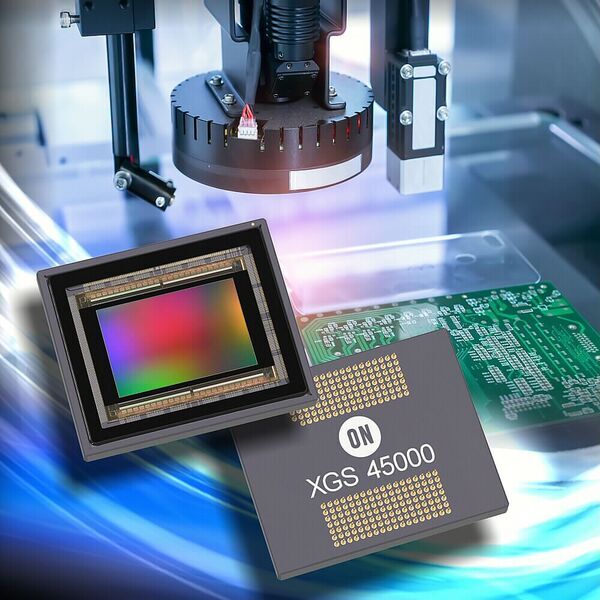
New XGS CMOS Image Sensors Enhance ON Semiconductor Offerings for High-Resolution Industrial Imaging
"ON Semiconductor (Nasdaq: ON), driving energy efficient innovations, has expanded their XGS family of image sensors with high performance, low noise products that offer 12-bit image quality at a high frame rate. The new offerings include the XGS 45000, the XGS 30000 and the XGS 20000, which provide detailed imaging with up to 45 Mp for resolution critical applications and up to 60 fps in 8K video mode. Also available is the new XGS 5000, designed with low power performance and state-of-the art image quality for compact 29 x 29 mm2 camera designs. Alongside the XGS 5000, 3 Mp and 2 Mp variants have been released for production. All XGS devices feature a 3.2 µm pixel size giving high resolution while the advanced pixel design ensures low noise performance and image quality that is essential in challenging IoT applications such as machine vision and Intelligent Transportation Systems (ITS). A global shutter ensures that moving objects can be captured without any motion artifacts." [...]

Microchip Announces Microcontrollers that Solve Tough Analog System Design Challenges
"Adds MCUs that integrate configurable analog and digital peripherals supported by mixed-signal development environment Sensor-based Internet of Things (IoT) applications rely on a combination of analog functionality and digital control capability to meet a challenging list of requirements including low cost, small size, performance and low power. Addressing this challenge through a focus on increased microcontroller (MCU) integration, Microchip Technology Inc. (Nasdaq: MCHP) today announced the PIC18-Q41 and AVR DB MCU families that are the first to combine advanced analog peripherals and multi-voltage operation with inter-peripheral connections for increased system integration and reduced signal acquisition times, and offer the convenience and efficiency of operating in a single design environment. “Microchip is bringing easy-to-use analog capability to cost-effective PIC® and AVR® MCUs so designers can meet the requirements of large-scale IoT systems,” said Greg Robinson, associate vice president of marketing for Microchip’s 8-bit microcontroller business unit. “With a unified, seamless development tool experience, designers can use these MCUs as a single-chip controller, or as an intelligent analog signal conditioning component in a larger system.” To address the need for signal conditioning in space-constrained sensing and measuring applications such as IoT end nodes and industrial, medical devices, wearables, automotive and lighting systems, the PIC18-Q41 MCU has a configurable Operational Amplifier (Op Amp) and Analog-to-Digital Converter (ADC) with computation and Digital-to-Analog Converters (DACs). It is particularly well-suited for IoT and large-scale artificial intelligence (AI) at-the-edge, including predictive maintenance edge nodes in a smart factory. Offered in compact 14- and 20-pin packages, the PIC18-Q41 MCU also makes a good companion to Microchip’s 32-bit MCUs and other controllers that require analog integration." [...]

SpaceX just launched 60 new Starlink internet satellites and nailed rocket landing at sea
"There's more than 800 Starlink satellites in orbit now. SpaceX successfully launched a full stack of Starlink internet satellites into today (Oct. 18) and capped off the mission with a successful rocket landing at sea. A two-stage Falcon 9 rocket blasted off from NASA's historic Pad 39A here at NASA's Kennedy Space Center at 8:25 a.m. EDT (1225 GMT) carrying 60 new Starlink satellites for SpaceX's growing constellation in orbit. Approximately 9 minutes later, the booster's first stage returned to Earth, landing on one of SpaceX's drone ships in the Atlantic Ocean in a smooth touchdown. The massive ship, called Of Course I Still Love You, is one of two in the company’s fleet of recovery vessels that catch falling boosters and return them to port. It was nothing but blue skies over the Space Coast today." [...]
Ciência e Tecnologia

Monash engineers improve fatigue life of high strength aluminium alloys by 25 times
"A world-first study by Monash University engineers has demonstrated improvements in the fatigue life of high strength aluminium alloys by 25 times – a significant outcome for the transport manufacturing industry. Published today (Thursday 15 October 2020) in the prestigious journal Nature Communications, researchers demonstrated that the poor fatigue performance of high strength aluminium alloys was because of weak links called ‘precipitate free zones’ (PFZs). The team led by Professor Christopher Hutchinson, a Professor of Materials Science and Engineering at Monash University in Australia, was able to make aluminium alloy microstructures that can heal the weak links while in operation (i.e. a form of self-healing). The improvement in the lifetime of high strength aluminium alloys could be 25 times compared to current state-of-the-art alloys. Aluminium alloys are the second most popular engineering alloy in use today." [...]

Pinning down the ampere with a supersensitive particle detector
"From light bulbs to cell phones, all electronic devices in everyday life rely on the flow of electrons to function. Just as scientists use meters to describe the length of an object or seconds to measure the passage of time, they use amperes, or amps, to quantify electric current — the rate at which electric charge moves through a circuit. In everyday life, you can safely use a hair dryer or toaster without knowing exactly how many electrons are flowing through it every second. But researchers on the frontiers of physics must have a precise definition of the ampere to detect when experiments unexpectedly deviate from theoretical predictions. “As technology progresses, lots of measurements that we could not do before become available, and then you can have extremely high-precision measurements,” said Fermilab scientist Javier Tiffenberg. “So you want to have a definition of the unit that is much more precise than whatever you are trying to measure.” For decades, scientists have struggled to achieve the necessary precision for the ampere." [...]

New CubeSat will observe the remnants of massive supernovas
"Scientists at CU Boulder are developing a satellite about the size of a toaster oven to explore one of the cosmos’ most fundamental mysteries: How did radiation from stars punch its way out of the first galaxies to fundamentally alter the make-up of the universe as it we know it today. Those insights will come from the Supernova Remnants and Proxies for ReIonization Testbed Experiment (SPRITE), a NASA-funded mission led by the Laboratory for Atmospheric and Space Physics (LASP) at CU Boulder. Scheduled to launch in 2022, the $4 million SPRITE is the latest in LASP’s line of little-spacecraft-that-could. This “CubeSat” will measure just over a foot in length and will weigh about 40 pounds. It will also collect unprecedented data from modern-day stars and supernovas to help scientists better understand a time in the history of the cosmos called the “Epoch of Reionization”—a period in which the universe’s first stars lived fast and hard, burning out and going supernova in a span of just a few million years. “We’re trying to establish what the universe was like when it first formed and how it evolved to where it is today,” said Brian Fleming, a research professor at LASP who is leading the SPRITE mission." [...]

A trillion turns of light nets terahertz polarized bytes
"Nanophotonics researchers demonstrate ultrafast polarization switching U.S. and Italian engineers have demonstrated the first nanophotonic platform capable of manipulating polarized light 1 trillion times per second. “Polarized light can be used to encode bits of information, and we’ve shown it’s possible to modulate such light at terahertz frequencies,” said Rice University’s Alessandro Alabastri, co-corresponding author of a study published this week in Nature Photonics. “This could potentially be used in wireless communications,” said Alabastri, an assistant professor of electrical and computer engineering in Rice’s Brown School of Engineering. “The higher the operating frequency of a signal, the faster it can transmit data. One terahertz equals 1,000 gigahertz, which is about 25 times higher than the operating frequencies of commercially available optical polarization switches.” The research was a collaboration between experimental and theoretical teams at Rice, the Polytechnic University of Milan (Politecnico) and the Italian Institute of Technology (IIT) in Genoa. This collaboration started in the summer of 2017, when study co-first author Andrea Schirato was a visiting scholar in the Rice lab of physicist and co-author Peter Nordlander." [...]
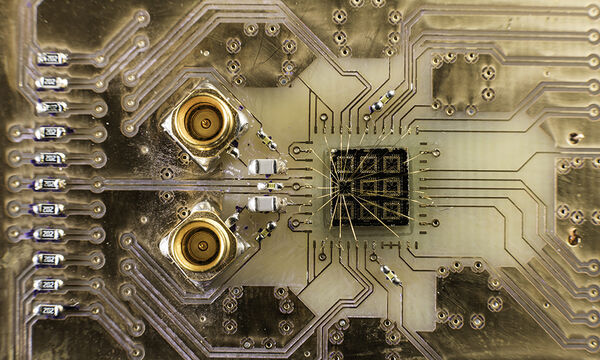
Quantum engines? Entanglement as fuel?
"It’s still more science fiction than science fact, but perfect energy efficiency may be one step closer due to new research at the University of Rochester. In order to make a car run, a car’s engine burns gasoline and converts the energy from the heat of the combusting gasoline into mechanical work. In the process, however, energy is wasted; a typical car only converts around 25 percent of the energy in gasoline into useful energy to make it run. Engines that run with 100 percent efficiency are still more science fiction than science fact, but new research from the University of Rochester may bring scientists one step closer to demonstrating an ideal transfer of energy within a system. Andrew Jordan, a professor of physics at Rochester, was recently awarded a three-year, $1 million grant from the Templeton Foundation to research quantum measurement engines—engines that use the principles of quantum mechanics to run with 100 percent efficiency. The research, to be carried out with co-principal investigators in France and at Washington University St. Louis, could answer important questions about the laws of thermodynamics in quantum systems and contribute to technologies such as more efficient engines and quantum computers." [...]

Samara Scientists Explore into Creating a Cryogenic Engine for Unmanned Aerial Vehicles
"Scientists of the Samara National Research University have started to develop a cryogenic engine that will use liquid nitrogen or liquefied natural gas as fuel. In the future that engine can be used to power environmentally friendly vehicles in specially protected natural areas, as well as special purpose unmanned aerial vehicles (UAVs), which can remain invisible to infrared tracking devices as they will leave no thermal traces in the sky, according to their developers. The work is carried out within the scope of the laboratory for cryogenic technology started at the Samara University. "The main task of this laboratory is to study the prospects of using cold energy, that is, the energy stored in cryogenic substances and products. The laboratory has started developing a cryogenic engine, and currently a series of tests is underway on one of the main elements of the newly developed engine – a cryogenic fuel storage system," Dmitry Uglanov, Deputy Director of the Institute of Engines and Power Plants of the Samara University, Associate Professor of the Chair of Thermal Engineering and Thermal Engines and Scientific Director of the laboratory for cryogenic technology said. ." [...]

The new heavy isotope mendelevium-244 and a puzzling short-lived fission activity
"Gaining a better understanding of the limiting factors for the existence of stable, superheavy elements is a decade-old quest of chemistry and physics. Superheavy elements, as are called the chemical elements with atomic numbers greater than 103, do not occur in nature and are produced artificially with particle accelerators. They vanish within seconds. A team of scientists from GSI Helmholtzzentrum für Schwerionenforschung Darmstadt, Johannes Gutenberg University Mainz (JGU), Helmholtz Institute Mainz (HIM) and the University of Jyväskylä, Finland, led by Dr. Jadambaa Khuyagbaatar from GSI and HIM, has provided new insights into the fission processes in those exotic nuclei and for this, has produced the hitherto unknown nucleus mendelevium-244. The experiments were part of "FAIR Phase 0", the first stage of the FAIR experimental program. The results have now been published in the journal "Physical Review Letters"." [...]

A flexible color-changing film inspired by chameleon skin
"Chameleons can famously change their colors to camouflage themselves, communicate and regulate their temperature. Scientists have tried to replicate these color-changing properties for stealth technologies, anti-counterfeiting measures and electronic displays, but the materials have limitations. Now, researchers have developed a flexible film that changes color in response to stretching, pressure or humidity. They report their results in ACS Applied Materials & Interfaces. Watch a video of the chameleon-inspired material here. By tensing or relaxing their skin, chameleons can change the way light reflects from guanine crystals under the surface, producing what’s known as structural coloration." [...]
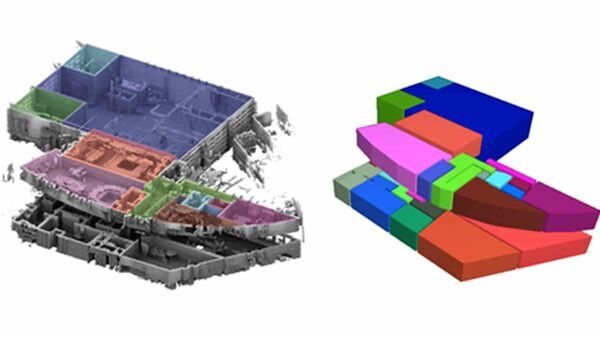
Creating 3D maps of complex buildings for disaster management
"In case of an emergency, first responders like the fire brigade need up-to-date information. 2D maps are a common source of information but they can be difficult to read in an emergency situation. UT PhD-student Shayan Nikoohemat created an algorithm that can accurately generate 3D models of the insides of large buildings from point clouds. Indoor 3D models are the digital twins of building interiors. The 3D models could be used by first responders to get a good impression of large buildings, like shopping malls, a hospital or a sports complex, on their way to the emergency. 2D maps represent important information – like the location of emergency exits – on tangled floor plans, making them difficult too read quickly and after each reconstruction, these maps are outdated." [...]

A New Ultrafast Control Scheme of Ferromagnet for Energy-Efficient Data Storage
"The digital data generated around the world every year is now counted in zettabytes, or trillions of billions of bytes - equivalent to delivering data for hundreds of millions of books every second. The amount of data generated continues to grow. If existing technologies remained constant, all the current global electricity consumption would be devoted to data storage by 2040. Researchers at the Université de Lorraine in France and Tohoku University reported on an innovative technology that leads to a drastic reduction in energy for data storage. The established technology utilizes an ultrafast laser pulse whose duration is as short as 30 femto seconds - equal to 0.0000000000000003 seconds. The laser pulse is applied to a heterostructure consisting of ferrimagnetic GdFeCo, nonmagnetic Cu and ferromagnetic Co/Pt layers." [...]

Zeptoseconds: New world record in short time measurement
"In the global race to measure ever shorter time spans, physicists from Goethe University Frankfurt have now taken the lead: together with colleagues at the accelerator facility DESY in Hamburg and the Fritz-Haber-Institute in Berlin, they have measured a process that lies within the realm of zeptoseconds for the first time: the propagation of light within a molecule. A zeptosecond is a trillionth of a billionth of a second (10-21 seconds). In 1999, the Egyptian chemist Ahmed Zewail received the Nobel Prize for measuring the speed at which molecules change their shape. He founded femtochemistry using ultrashort laser flashes: the formation and breakup of chemical bonds occurs in the realm of femtoseconds. A femtosecond equals 0.000000000000001 seconds, or 10-15 seconds. Now atomic physicists at Goethe University in Professor Reinhard Dörner’s team have for the first time studied a process that is shorter than femtoseconds by magnitudes." [...]

NTHU Researchers Make Major Breakthrough in Quantum Dot Technology
"You probably already know that placing a pared apple in saltwater prevents it from turning black from oxidation, but do you also know that saltwater can also be used to protect fragile quantum dot material? A research team led by Prof. Sean Chen of the Department of Materials Science and Engineering has recently developed the world’s first quantum dot material using saltwater as a coating, which not only resists water and oxygen corrosion, but can also be uniformly printed as a micro LED on flexible plastic film for use in high-resolution mobile phones, glasses, etc. The team’s research has been published in a recent issue of ACS Applied Materials & InterfacesACS Applied Materials & Interfaces, and the material they have developed is currently being patented in the United States and Taiwan. Eager to develop displays which are high-resolution, high-brightness, ultra-thin, flexible, and long-life for use in the goggles used in augmented reality (AR) and virtual reality (VR), and for watches and other wearable electronic devices, Apple, Samsung and other major panel manufacturers have invested heavily in the research and development of micro LEDs to replace the current OLEDs. But arranging millions of LED dots less than 100 microns in size onto a substrate is no easy task. According to Chen, many manufacturers use a stamping method to move millions of red, green, and blue micro LEDs one by one to the substrate, but if a few small dots don’t stick, the screen will be marred by dead pixels." [...]

Microwave lenses harnessed for multi-beam forming
"This highly compact beam forming network has been designed for multi-beam satellite payload antennas. Generating a total of 64 signal beams outputted from a single antenna, this novel design could cover the entire Earth with multiple spot beams from geostationary orbit. “The traditional solution for a multibeam telecommunications satellite payload would be a single feed per signal beam, but only a limited number of feeds are able to be accommodated in front of the satellite antenna, with each feed requiring a dedicated amplifier,” explains Petar Jankovic of ESA’s Radio Frequency Equipment and Technology section. “This is a highly integrated, lower mass alternative, developed with Airbus in Italy.” What looks like a sunburst design is actually a ‘Rotman’ lens, laid down on a printed circuit board, used to direct and focus microwaves. These are commonly employed in terrestrial radar systems, for instance aboard high-end drones or in-car radar, and are also being looked at for future 5G base stations. A single flat Rotman lens allows beam scanning along a single axis." [...]
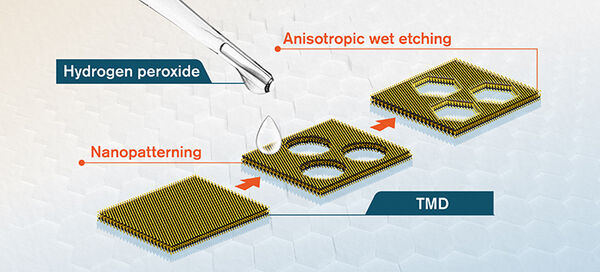
How to make perfect edges in 2D-materials
"Ultrathin materials such as graphene promise a revolution in nanoscience and technology. Researchers at Chalmers University of Technology, Sweden, have now made an important advance within the field. In a recent paper in Nature Communications they present a method for controlling the edges of two-dimensional materials using a ‘magic’ chemical. “Our method makes it possible to control the edges – atom by atom – in a way that is both easy and scalable, using only mild heating together with abundant, environmentally friendly chemicals, such as hydrogen peroxide,” says Battulga Munkhbat, a postdoctoral researcher at the Department of Physics at Chalmers University of Technology, and first author of the paper. Materials as thin as just a single atomic layer are known as two-dimensional, or 2D, materials. The most well-known example is graphene, as well molybdenum disulphide, its semiconductor analogue." [...]

Scientists Discover New Remarkable Materials Properties at Ultrahigh Pressure
"An international team of scientists from NUST MISIS (Russia), Linköping University (Sweden) and University of Bayreuth (Germany) found that, contrary to the usual physical and chemical laws, the structure of some materials does not condense at ultrahigh pressures. Actually, it forms a porous framework filled with gas molecules. This happened with samples of Os, Hf, and W put together with N in a diamond anvil at a pressure of one million atmospheres. The discovery is described in Angewandte Chemie. “You can transform a pencil lead into diamond if you squeeze it very hard” — this fact heard by many of us in childhood sounded like a complete nonsense. However, science laws make it clear that there is no miracle: both pencil lead and diamond are formed by the same chemical element, i.e." [...]
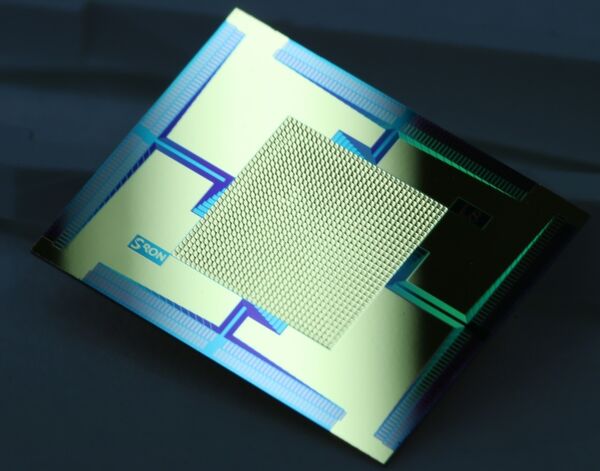
Technology ready for back-up detector X-IFU in Athena space telescope
"In 2031, ESA launches its new X-ray space telescope Athena. SRON plays a large role in building one of its two instruments, the X-IFU spectrometer, by producing the camera plus the back-up detectors. SRON scientists have now successfully developed detectors that are optimized for a readout based on a special system called Frequency Domain Multiplexing. They set a new world-record energy resolution at 6 keV of 1.3 eV. From its orbit around the Sun, 1.5 million kilometers behind Earth, Athena will map hot gas structures in the Universe and study the evolution of supermassive black holes. For that it needs to measure their spectra with unprecedented resolution." [...]

Ultrafast Camera Films 3-D Movies at 100 Billion Frames Per Second
"In his quest to bring ever-faster cameras to the world, Caltech's Lihong Wang has developed technology that can reach blistering speeds of 70 trillion frames per second, fast enough to see light travel. Just like the camera in your cell phone, though, it can only produce flat images. Now, Wang's lab has gone a step further to create a camera that not only records video at incredibly fast speeds but does so in three dimensions. Wang, Bren Professor of Medical Engineering and Electrical Engineering in the Andrew and Peggy Cherng Department of Medical Engineering, describes the device in a new paper in the journal Nature Communications. The new camera, which uses the same underlying technology as Wang's other compressed ultrafast photography (CUP) cameras, is capable of taking up to 100 billion frames per second. That is fast enough to take 10 billion pictures, more images than the entire human population of the world, in the time it takes you to blink your eye." [...]

New technology diagnoses sickle cell disease in record time
"Diseases of the blood, like sickle cell disease, have traditionally taken a full day, tedious lab work and expensive equipment to diagnose, but researchers at the University of Colorado Boulder and the University of Colorado Anschutz have developed a way to diagnose these conditions with greater sensitivity and precision in only one minute. Their technology is smaller than a quarter and requires only a small droplet of blood to assess protein interactions, dysfunction or mutations. Assistant Professor Xiaoyun Ding of the Paul M. Rady Department of Mechanical Engineering and Associate Professor Michael Stowell of the Department of Molecular, Cellular and Developmental Biology at CU Boulder, along with Associate Professor Angelo D’Alessandro of the Departments of Biochemistry and Molecular Genetics and Medicine, Division of Hematology at CU Anschutz, co-authored a paper about the technology, now featured as the front cover of Small. This project began when Ding realized that a technology developed in his lab could increase the speed of cell protein analysis performed by Stowell and his research group. As Stowell and D’Alessandro got involved, new applications emerged, including disease diagnosis. “In Africa, sickle cell disease is the cause of death in 5% of children under 5 years old for lack of early diagnosis,” said D’Alessandro." [...]

What A Crystal Reveals About Nuclear Materials Processing
"PNNL researchers devise a new method to analyze Hanford site plutonium microcrystals. While studying legacy contaminated soil samples from the Plutonium Finishing Plant waste crib at the Hanford Site (Richland, WA), Pacific Northwest National Laboratory (PNNL) researchers located and extracted tiny crystals containing plutonium. How, they wondered, had the crystals formed? To understand the crystals’ history, the researchers must first understand their chemical structure, also known as speciation. Because plutonium can act very differently depending on how it combines with other elements, knowing the crystals’ speciation is a critical part of safe storage and environmental remediation. These activities are key parts of the U.S. Department of Energy’s cleanup mission at former nuclear material processing sites and facilities." [...]
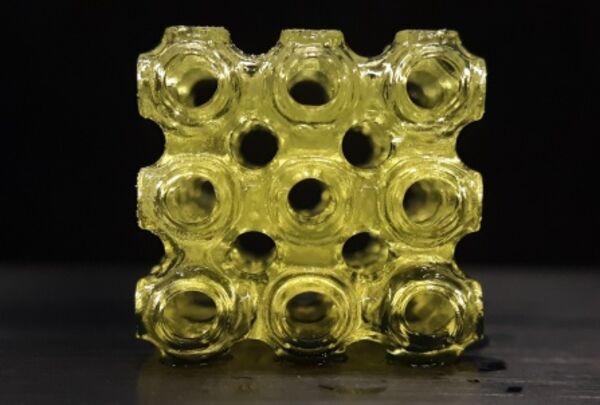
UB researchers develop new molecular ferroelectric metamaterials
"The work could advance smart materials, soundproofing materials, shock absorbers, elastics cloaks and more A University at Buffalo-led research team has reported a new 3D-printed molecular ferroelectric metamaterial. The advancement, published Monday in the Proceedings of the National Academy of Sciences, is a step toward making these extraordinary lab-created materials more affordable and adaptable to countless multifunctional technologies. It could benefit everything from acoustic blankets for aircraft soundproofing to shock absorbers and elastic cloaks that shield sensitive electronic systems from external mechanical disturbances. “The sky is the limit when it comes to ferroelectric metamaterials,” says the study’s lead author, Shenqiang Ren, PhD, professor in the Department of Mechanical and Aerospace Engineering at the UB School of Engineering and Applied Sciences. Among the research interests of Ren, who holds appointments in UB’s Department of Chemistry and the university’s RENEW Institute, is the design and assembly of high-temperature molecular ferroelectrics. For the study, he assembled a team that includes: Chi Zhou, PhD, associate professor in UB’s Department of Industrial and Systems Engineering." [...]

Electronic design tool morphs interactive objects
"MorphSensor lets users digitally model an object’s form and electronic function in one integrated space. We’ve come a long way since the first 3D-printed item came to us by way of an eye wash cup, to now being able to rapidly fabricate things like car parts, musical instruments, and even biological tissues and organoids. While much of these objects can be freely designed and quickly made, the addition of electronics to embed things like sensors, chips, and tags usually requires that you design both separately, making it difficult to create items where the added functions are easily integrated with the form. Now, a 3D design environment from MIT’s Computer Science and Artificial Intelligence Laboratory (CSAIL) lets users iterate an object’s shape and electronic function in one cohesive space, to add existing sensors to early-stage prototypes. The team tested the system, called MorphSensor, by modeling an N95 mask with a humidity sensor, a temperature-sensing ring, and glasses that monitor light absorption to protect eye health. MorphSensor automatically converts electronic designs into 3D models, and then lets users iterate on the geometry and manipulate active sensing parts." [...]
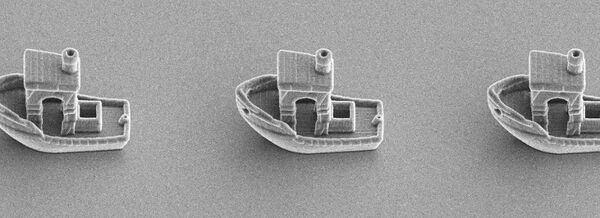
3D printed microboat
"From prow to stern, this little boat measures 30 micrometers, about a third of the thickness of a hair. It has been 3D-printed by Leiden physicists Rachel Doherty, Daniela Kraft and colleagues. The image was made using an electron microscope and can be found in their article about 3D printing synthetic microswimmers in the scientific journal Soft Matter. Microswimmers Kraft's research group researches microswimmers, small particles moving in fluids like water, that can be followed using a microscope. One of their goals is understanding biological microswimmers, such as bacteria. Most research of this type is carried out on sphere shaped particles, but 3D printing offers new possibilities, as the researchers show in this article." [...]
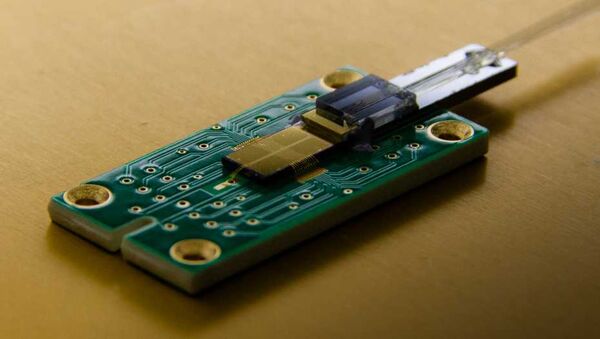
Optical wiring for large quantum computers
"Researchers at ETH have demonstrated a new technique for carrying out sensitive quantum operations on atoms. In this technique, the control laser light is delivered directly inside a chip. This should make it possible to build large-scale quantum computers based on trapped atoms. Hitting a specific point on a screen with a laser pointer during a presentation isn’t easy – even the tiniest nervous shaking of the hand becomes one big scrawl at a distance. Now imagine having to do that with several laser pointers at once. That is exactly the problem faced by physicists who try to build quantum computers using individual trapped atoms." [...]
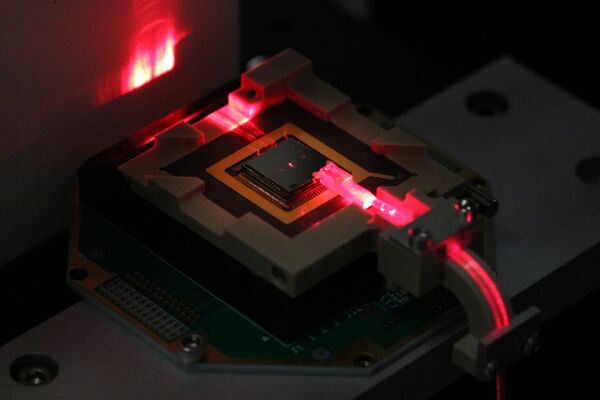
Lighting up the ion trap
"Fiber optics built into a chip can deliver all the laser light needed to control ions for quantum computing and sensing. Walk into a quantum lab where scientists trap ions, and you'll find benchtops full of mirrors and lenses, all focusing lasers to hit an ion "trapped" in place above a chip. By using lasers to control ions, scientists have learned to harness ions as quantum bits, or qubits, the basic unit of data in a quantum computer. But this laser setup is now holding research back — making it difficult to experiment with more than a few ions and to take these systems out of the lab for real use. Now, Lincoln Laboratory researchers have developed a compact way to deliver laser light to trapped ions. In a paper published in Nature, the researchers describe a fiber-optic block that plugs into the ion-trap chip, coupling light to optical waveguides fabricated in the chip itself." [...]
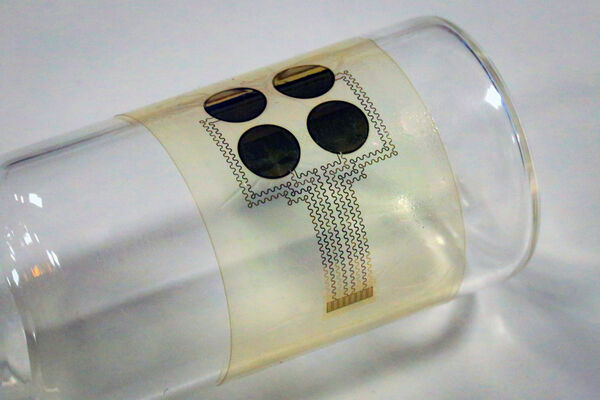
A wearable sensor to help ALS patients communicate
"Researchers have designed a skin-like device that can measure small facial movements in patients who have lost the ability to speak. People with amyotrophic lateral sclerosis (ALS) suffer from a gradual decline in their ability to control their muscles. As a result, they often lose the ability to speak, making it difficult to communicate with others. A team of MIT researchers has now designed a stretchable, skin-like device that can be attached to a patient’s face and can measure small movements such as a twitch or a smile. Using this approach, patients could communicate a variety of sentiments, such as “I love you” or “I’m hungry,” with small movements that are measured and interpreted by the device. The researchers hope that their new device would allow patients to communicate in a more natural way, without having to deal with bulky equipment." [...]
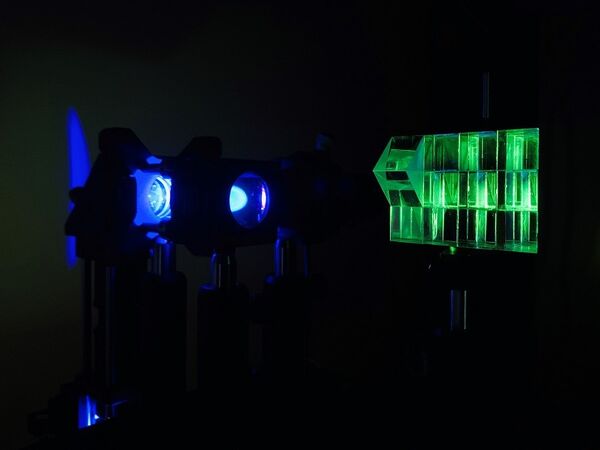
Researchers Develop Simple Way to Capture High Quality 3D Images of Live Cells and Organisms
"New approach captures multifocus microscopy images with high speeds. Researchers have developed a simple method for simultaneously acquiring images at different depths with a standard microscope. The new technique can be applied to a variety of microscopy methods, making it useful for a wide range of biological and biomedical imaging applications. “Optical microscopy has been an indispensable tool for studying 3D complex biological systems and processes,” said Sheng Xiao, a member of the research team from Boston University. “Our new multifocus technique allows live cells and organisms to be observed at high speeds and with high contrast.” In Optica, The Optical Society's (OSA) journal for high impact research, researchers led by Jerome Mertz describe their new straightforward and fast way to acquire information from different depths with standard microscopy. The new approach can be simply added to most existing systems and is easy to replicate, making it accessible to other researchers." [...]
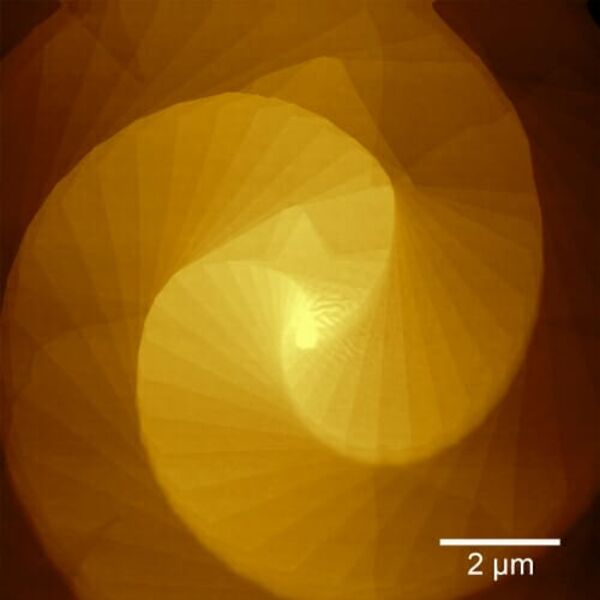
Do the twist: Making two-dimensional quantum materials using curved surfaces
"Scientists at the University of Wisconsin–Madison have discovered a way to control the growth of twisting, microscopic spirals of materials just one atom thick. The continuously twisting stacks of two-dimensional materials built by a team led by UW–Madison chemistry Professor Song Jin create new properties that scientists can exploit to study quantum physics on the nanoscale. The researchers published their work today in the journal Science. “This is the current frontier of 2D material research. In the last few years, scientists have realized that when you make a small twist between atomic layers — usually a few degrees — you create very interesting physical properties, such as unconventional superconductivity. For example, the twisted material loses its electrical resistance completely at the low temperature,” says Jin." [...]

Closing the Plastic Loop
"Researchers develop an efficient, low-energy method for upcycling polyethylene plastic waste into valuable molecules that can be repurposed for further use When we started using plastics about 70 years ago, not much thought — if any — was given to the implications of their lifespan and the fact that they can take centuries to decompose. Consequently, as plastics have diversified and become easier to manufacture, the planet is now straddling some 8.3 billion tons of the stuff — almost every bit of plastic ever produced — without enough technology or incentives to shrink that growing pile. Plastic is cheaper and easier to produce and throw away than it is to recycle. UC Santa Barbara researchers Susannah Scott and Mahdi Abu-Omar are poised to shift this decades-old paradigm. How? With a one-pot, low-temperature catalytic method that upcycles polyethylene — a polymer that is found in about a a third of all plastics produced, with a global value of about $200 billion annually — into high-value alkylaromatic molecules that are the basis of many industrial chemicals and consumer products." [...]
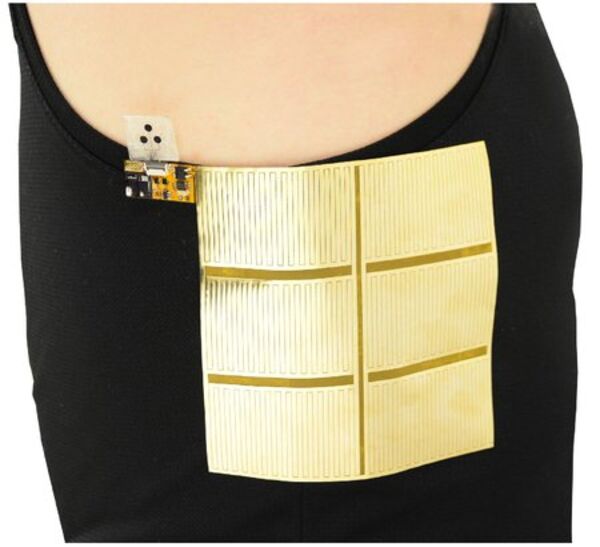
New Device Powers Wearable Sensors Through Human Motion
"The advent of inexpensive wearable sensors that can monitor heart rate and body temperature, as well as levels of blood sugar and metabolic byproducts, has allowed researchers and health professionals to monitor human health in ways never before possible. But like all electronic devices, these wearable sensors need a source of power. Batteries are an option, but are not necessarily ideal because they can be bulky, heavy, and run out of charge. Caltech's Wei Gao, assistant professor of medical engineering in the Andrew and Peggy Cherng Department of Medical Engineering, has been developing these sensors as well as novel approaches to power them using the human body itself. Previously, he created a sensor that could monitor health indicators in human sweat that is powered by sweat itself. Now, Gao has developed a new way to power wireless wearable sensors: He harvests kinetic energy that is produced by a person as they move around." [...]
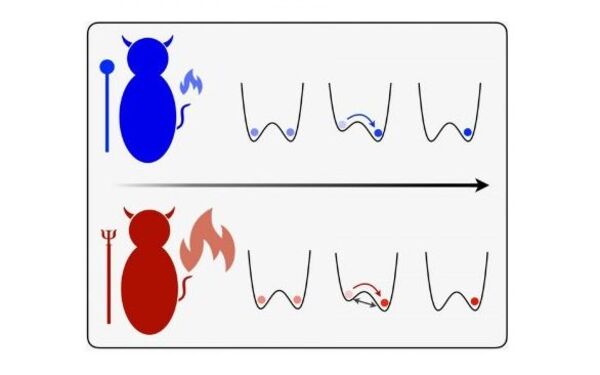
The demon is in the detail – Trinity team discovers uniquely quantum effect in erasing information
"Researchers from Trinity have discovered a uniquely quantum effect in erasing information that may have significant implications for the design of quantum computing chips. Their surprising discovery brings back to life the paradoxical “Maxwell’s demon”, which has tormented physicists for over 150 years. The thermodynamics of computation was brought to the fore in 1961 when Rolf Landauer, then at IBM, discovered a relationship between the dissipation of heat and logically irreversible operations. Landauer is known for the mantra “Information is Physical”, which reminds us that information is not abstract and is encoded on physical hardware. The “bit” is the currency of information (it can be either 0 or 1) and Landauer discovered that when a bit is erased there is a minimum amount of heat released. This is known as Landauer’s bound and is the definitive link between information theory and thermodynamics." [...]
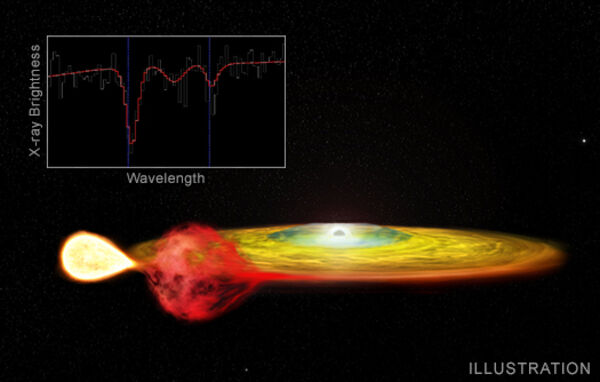
Einstein's Theory of Relativity, Critical for GPS, Seen in Distant Stars
"What do Albert Einstein, the Global Positioning System (GPS), and a pair of stars 200,000 trillion miles from Earth have in common? The answer is an effect from Einstein's General Theory of Relativity called the "gravitational redshift," where light is shifted to redder colors because of gravity. Using NASA's Chandra X-ray Observatory, astronomers have discovered the phenomenon in two stars orbiting each other in our galaxy about 29,000 light years (200,000 trillion miles) away from Earth. While these stars are very distant, gravitational redshifts have tangible impacts on modern life, as scientists and engineers must take them into account to enable accurate positions for GPS. While scientists have found incontrovertible evidence of gravitational redshifts in our solar system, it has been challenging to observe them in more distant objects across space. The new Chandra results provide convincing evidence for gravitational redshift effects at play in a new cosmic setting." [...]
Documentação
A documentação é parte essencial do processo de aprendizagem e a Internet além de artigos interessantes de explorar também tem alguma documentação em formato PDF interessante de ler. Todos os links aqui apresentados são para conteúdo disponibilizado livremente pelo editor do livro.
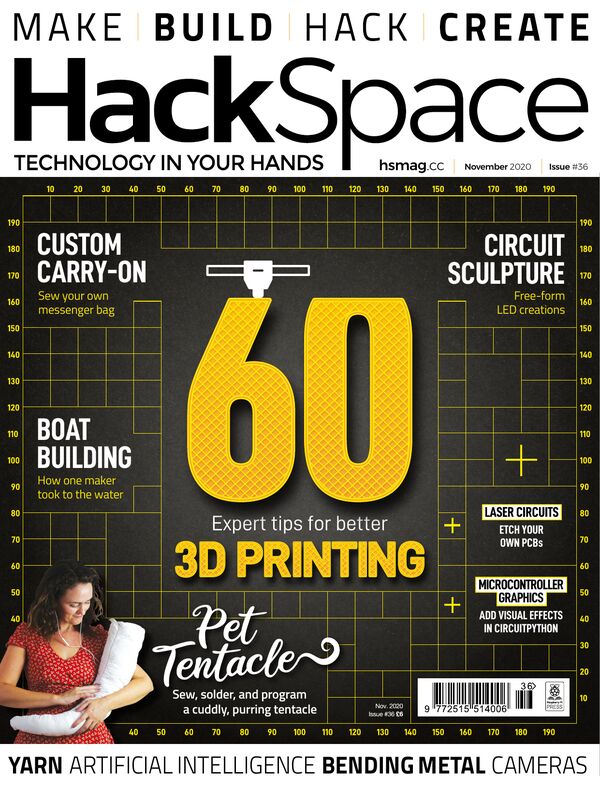
HackSpace magazine #36
"3D printing is one of the defining technologies of our age, but it can be a little tricky at times. We’ve poked and prodded our experts and squeezed out 60 tips, tricks and techniques to help your 3D printing journey go as smoothly as possible. Sew a musical tentacle We get started with circuit sculpture Your name in lights with Circuit Python Laser-etch your own artwork" [...]
Projetos Maker
Diversos Projetos interessantes.

Speed Line Follower Robot V4
"This is my second line follower robot (Version 4). Unlike the previous one, I have made the design of the printed circuit (Chassis). This is my second Line Follower Robot (Version 4). Unlike the previous one, I have made the design of the printed circuit using EasyEDA. This printed circuit acts as the chassis of the robot. The PCB manufacturing has been carried out by JLCPCB and I must say that they exceeded my expectations with impressive quality and shipment in record time." [...]
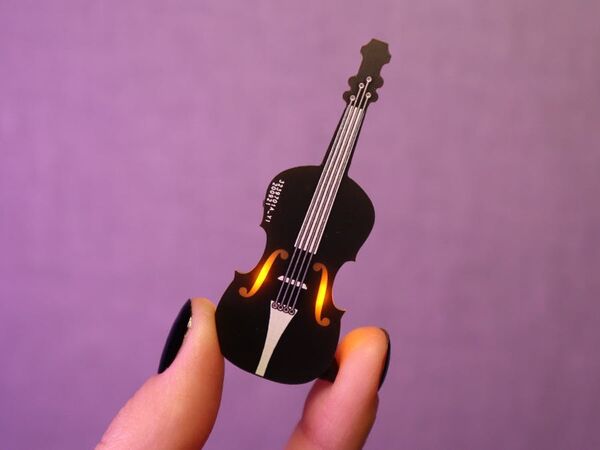
ATtiny85 Mini PCB Violin
"A tiny violin for playing tiny tunes Designing and building this tiny violin was a fun way to experiment with building my own microcontroller development board from scratch, as I've been meaning to do for a while. So I'll be documenting the whole process here, from PCB design to programming the microcontroller. 1. Circuit Schematic and PCB Design The first step was choosing the microcontroller I was going to use, based on the functionalities I wanted my violin to have. I needed at least one PWM pin for the piezoelectric buzzer and another two digital pins for the LEDs and for the push-button, so the ATtiny85 turned out to be the perfect fit. Circuit Schematic The circuit schematic is fairly simple." [...]

Text Teleporter
"Using Arduino, I show you how to copy text from one device and paste it in another device via Bluetooth, be it a smartphone or a laptop. This is my first project on Hackster and it's about relieving the fuss of copying some text from one device which has to be pasted in another device. I would sometimes mail or text myself what I wanted to paste and then open my mail or Facebook to copy that text. Although Google now offers a service where you can paste onto your desktop if you have Chrome and a Google account, I wanted to create an overall solution which would work across any device ( And mostly because I like to tinker with Arduino and wanted to create a simple yet useful project for all). This project is fairly easy and can be made by anyone, even if you haven't used an Arduino before. So if you feel you've faced this problem, feel free to indulge and try this project for yourself." [...]

Home Automation with NodeMCU LDR Temperature Control Relay
"In Manual Mode, control the relay module from Touch Switch & Blynk App. In Auto Mode, DHT11 & LDR will control the Relays Automatically. In this IoT based home automation project, I have made home automation using Blynk & NodeMCU with Touch Sensor, LDR, Temperature control relay module with real-time feedback. This smart home project has the following features: 1. Home appliances controlled from Mobile using Blynk App 2. Home appliances controlled by temperature & Humidity sensor automatically (In Auto Mode) 3." [...]

DIY HexaLeaf with Attiny85
"so this my HEXALEAF setup which is basically a DIY Nanoleaf made by combining 6 of these PCBs together in a hexagon shape. The goal here was to make a Cheap yet functional Nanoleaf like Light without using a 3D printer! one option was to make the Nanoleaf structure from Plastic Cardboard but it was a long and messy process that involves craft skills so I ditched that idea and made a super simple PCB version. the star of this project is this Nanoleaf PCB which I made in such a way that it has VCC Din and GND pads on one end and VCC Dout and GND on another end, when a signal starts from this PCB, the Signal gets transfer from the first PCB to the Second through these Din and Dout pads soldered together and this process goes on and on. so by this, we can prepare this setup in many shapes like triangle, square, hexagon, etc.." [...]

Arduino Plant Water Management System w/ BME280
"Track the total volume of water spent and evaluate approx. evaporation rates by temperature, humidity, and pressure to prevent water overuse Especially during a pandemic related to a virus that washing your hands is efficient to stop its spreading, it is crucial to preserve water sources even a little bit worldwide. Thus, in this project, I wanted to focus on a minuscule yet cumulative problem causing water overuse - watering plants. Although watering houseplants is an everyday task that most of us have not taken an interest in and therefore it is struggling to discern its effect on sustainable water supplies, repetitive water overuse adds up to tons of liters of water. To aid this problem, I decided to create a device that tracks the total water discharged while watering houseplants, evaluates the approximate evaporation rates by using temperature, humidity, barometric pressure, and lets the user observe soil moisture and altitude. To obtain temperature, humidity, barometric pressure, and approximate altitude, I used an Adafruit BME280 I2C or SPI Temperature Humidity Pressure Sensor." [...]
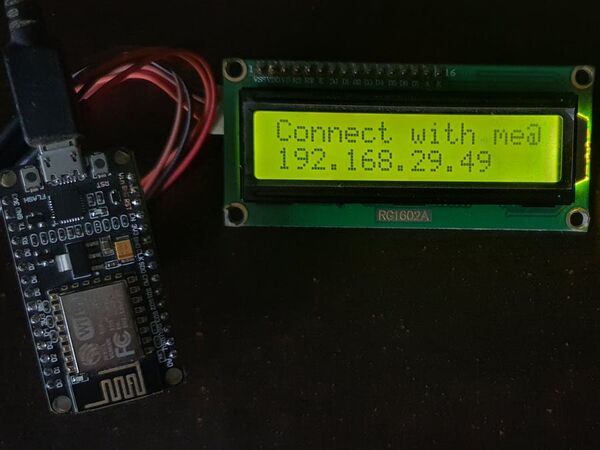
Wireless LCD Typer
"Wirelessly update text on LCD working as Standalone system. Ever wanted to update LCD which is out of reach? Try this random project with your code and use a web page to update it. Still working on UI. ( If have ideas do share ) This uses a web page to connect to Nodemcu on local WiFi network. Can also be programmed as standalone system with Access Point to allow users to connect with / without authentication." [...]
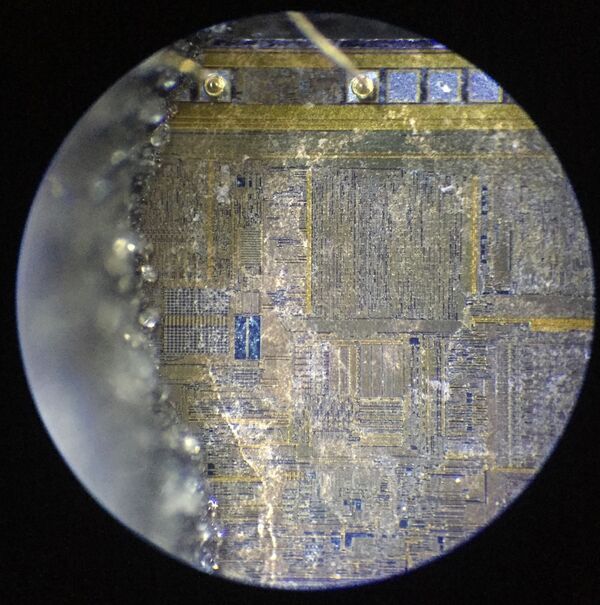
Learning to Decapsulate Integrated Circuits using Acid Deposition
"I’ve been looking to try my hand at IC decapsulation for years, and finally got the time to do it. The process took plenty of trial and error, so this post will document most of my failures and successes, and detail the methodologies used for each attempt. These are most of the ICs I worked on throughout the process: A typical chip is built as a silicon die, connected to its leads/contacts through bonding wires, and encapsulated in resin for protection. Of course, there are other ICs that use different designs and encapsulation materials: mostly metal and plastics. But the epoxy-based design is extremely common, so we’ll be focusing on it. " [...]
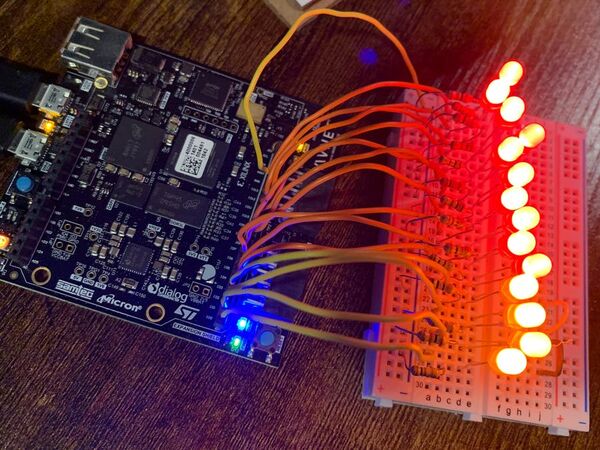
Enable Arduino I/O Header on the MiniZed
"Enable the digital I/O available on the Arduino shield header of the MiniZed. While working on another project, I noticed that the hardware design in the BSP for the MiniZed has the pinout of the Arduino GPIO header specified in the Vivado constraints file (.xdc) but it doesn't actually have them connected to anything in the hardware block design. I decided it would make a good standalone tutorial of how to enable the digital IO on the Arduino shield header as I haven't seen a ton of other specific resources for it. (Side Note: I am using Vivado/Vitis/PetaLinux 2019.2 for this project. I noticed while in the middle of this project that the Avnet Github repositories have updated quite a bit for version 2020.1, particularly for the MiniZed. So the exact steps for the Vitis aspect of this project and which files to upload to the MiniZed will be slightly different if you are using version Vivado/Vitis/PetaLinux 2020.1 or newer.)" [...]

YouTube Subscriber Counter Using an E-Paper Display and Raspberry Pi Zero W
"In this Instructable, I'll show you how to build your own Youtube Subscriber Counter using an e-paper display, and a Raspberry Pi Zero W to query the YouTube API and update the display. E-paper displays are great for this type of project as they have great readability, even in bright sunlight, and can be viewed from almost any angle, like paper. The display should be updated a minimum of once per day to prevent burn-in on the display, but I've set mine to update every three hours. This counter uses very little power as the display is only powered when it is updated, the rest of the time it is essentially off. The Raspberry Pi Zero W runs continuously on the back of the frame and uses around 0.6W while idle. Supplies: All you need for this project is a Raspberry Pi Zero W, an SD card and a Waveshare E-Ink Display, make sure that you order the display which includes the hat display controller for the Raspberry Pi." [...]

LED Matrix Metronome
"Combine Arduino, an 8*8 bicolour LED matrix and a piezo buzzer to make a cool visual metronome. I'm an Arduino fan and a musician. Practicing with a metronome is a great way to improve your musicianship, but most metronome apps are a little boring and don't have an engaging visual component. I'm a visual person so wanted to use Arduino and an LED matrix to make practicing more engaging. The project is very simple. There is an LED Matrix that displays patterns depending on the time signature." [...]

PumpkinPi
"Hardware Requirements: This project makes use of the following: Pumpkin - Carve a real one or you can always 3D print one Raspberry Pi Zero WH (UK, US) Pimoroni Unicorn pHat (UK, US) Micro SD Card (UK, US) USB power - I used the official Raspberry Pi Charger (UK, US) but you can also power with a USB battery pack. 3d Printed Pumpkin For the 3d printed pumpkin case, you will need: Glow in the Dark PLA Filament for body (UK, US) Green PLA Filament for top (UK, US) Adafruit Panel Mount Extension USB Cable - Micro B Male to Micro B Female [ADA3258] (UK, US) 4 x M2.5 threaded brass inserts (UK, US) 4 x M2.5 male PCB standoffs & screws - keep a kit of these handy if you don't have some. (UK, US)" [...]
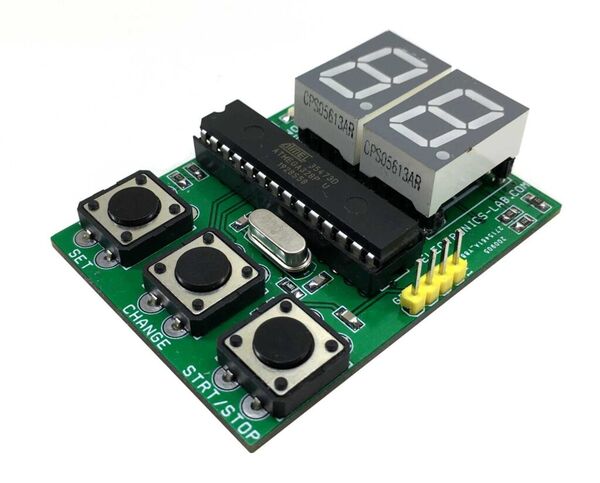
Arduino Compatible 2-Digit 7-Segment Display Board For Timer/Counter
"The project presented here is an open source 2-digit 7 segment Arduino compatible display board. It can used in many applications that require 2-digit display and switches inputs. Possible application of this board is a 2-digit counter, 2-digit countdown timer, token display, score board etc. 2 x 7 segment 0.56-inch Common cathode displays are used in multiplexing mode. Refer to the connection table to check connections between display segments and Atmega328 chip. A led connected to A4 pin of IC is used as indicator LED." [...]
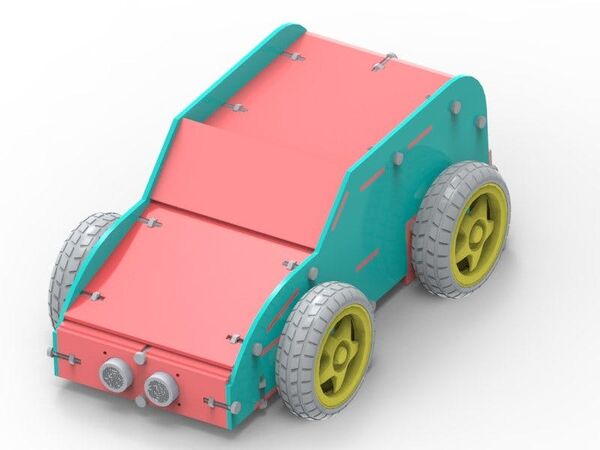
Arduino Robot Car
"You'll learn how to construct your first Arduino robot car and create your chassi. In the field of robotics, electronics, or electrical engineering, line-following robots are well known due to the competitions that encourage learning in this medium. Each competition has its rules, which specify the level of programming and electronics with which the robots must present themselves. The rules specify among the electronic components that may or may not be integrated into the robot, and depending on how the assembly will be made, and what equipment will be used, the developed programming may or may not be advanced. Depending on the devices that are used, the better is to develop a structure that behaves in the best possible way. Among the devices that can be part of the development of the robot, are the infrared (IR) sensors, the drive for the motors, the ultrasonic sensor, and the Arduino development platform." [...]
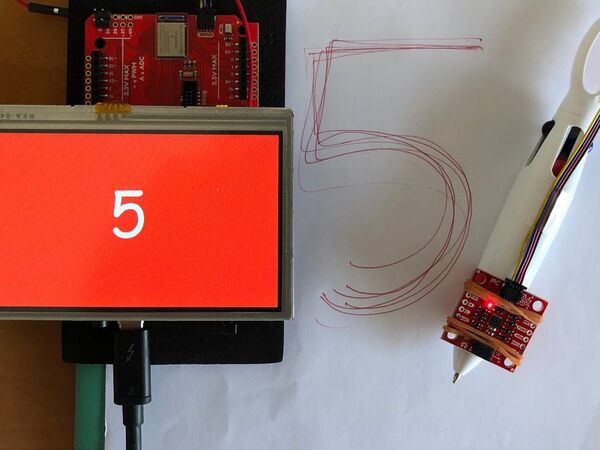
Handwriting Recognition
"This IMU-equipped pen is trained to recognize handwritten numbers Overview In this project, I build a pen device which can be used to recognize handwritten numerals. As its input, it takes multidimensional accelerometer and gyroscope sensor data. Its output will be a simple classification that notifies us if one of several classes of movements, in this case 0 to 9 digit, has recently occurred. Data collection for training The first and the most important step in a machine learning project is to collect the training data in such a way that it should cover most of the representative cases for a given classification task. To capture accelerometer and gyroscope data in a discrete real-time steps is a time consuming and error-prone task. I spent most of the time to collect data and look at it if it was captured correctly." [...]

WinchBot v1.5
"5 stepper motors with driver ICs, 3 standard servos and a Raspberry Pi result in a robot arm that can move in a 50x50x50cm box. WinchBot is a robot arm hanging on the ceiling. To make it work you don't have to cut all parts with high precision. It will work even if the parts of the frame are cut with a tolerance of +-3mm. It's a nice machine to teach about the Pythagorean theorem and about transformation from cable length to XYZ coordinates. " [...]
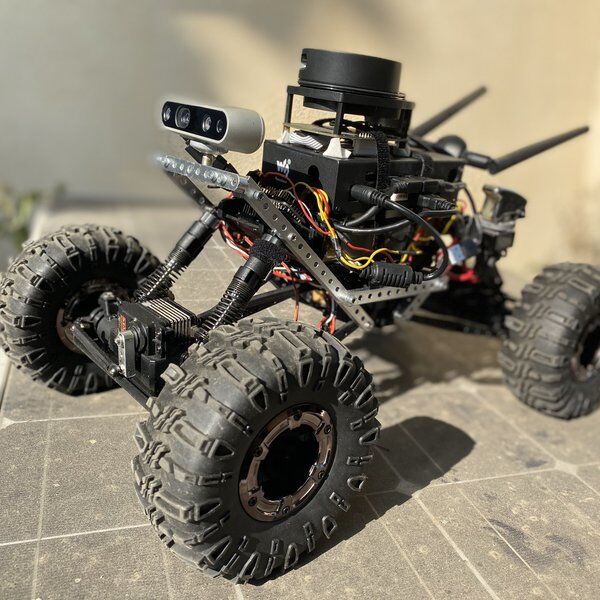
Jetson Nano Robot - Realsense, RPLidar, Joysticks
"Jetson Nano control and vision with 4-Wheel Steering, ROS2 RealSense2, RPlidar, BNO055, Python3, Pygame and ModBus Nvidia Jetson Nano control and vision with 4-Wheel Steering, ROS2 RealSense2, RPlidar, BNO055, Python3, Pygame and ModBus to drive the Jetson Nano using modbus joystick commands" [...]
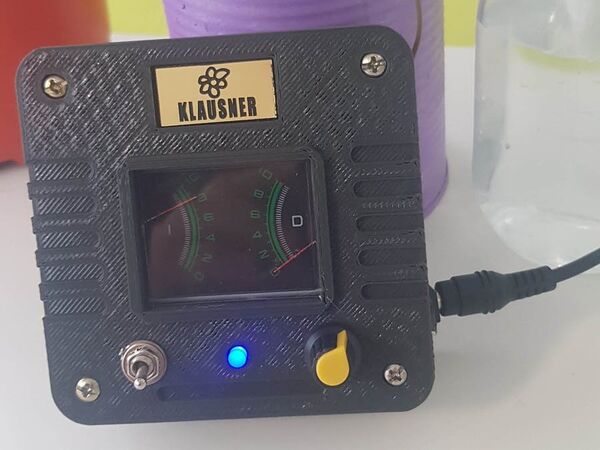
The Klausner Machine :: Hear Your Plants
"Roald Dahl wrote a short story named The Sound Machine. There, an inventor named Klausner develops a machine to hear plants painful shrieking noises when they are cut. Based on that idea I've made The Klausner Machine. In this case sounds are generated according to plant soil moisture conditions. Dry soil -> pain sounds Humid soil -> happy sounds Supplies: 1 Arduino Nano 1 Soil Moisture Sensor 1 DfPlayer Mini 1 MicroSD Card 1 4Ohm Speaker 2 Analog Vumeter 1 Led 1 Switch 1 Button Some cables" [...]

The Complete Daft Punk Helmet Build (Arduino Style)
"There have been others before me in making a Daft Punk helmet complete with electronics, however, I discovered that there few, if any, that provide a complete step by step instructional with the actual code to make the display work. Most do not go in depth on how the electronics was designed and built. Others have very thin vacuum formed helemts and / or inaccurate helmet designs. Lastly, there are many where there is far too much time spent on material choices (foam, etc.) that yields poor results. After much searching, I thought it was time to make one, and provide an instructable will all the "parts" needed to get it done without endless searches - and have the quality proporationate to the effort invested!" [...]

Big Wheel - Premiere Pro Video Deck
"Keyboards are the ultimate controller for video games (fight me, console peasants) but Premiere Pro demands a power level for which 104 buttons is not enough. We must Super Saiyan into a new form - we need KNOBS. This project takes big, big influence from MattRHale's glorious Elite Dangerous control pad, a project that would make nine-year-old Zack Freedman flip his metaphorical pogs. I also encountered HappyThingsMaker's Premiere Pro Edit Dial Controller while researching the project, which almost certainly influenced this project. The Big Wheel was built in one weekend (and a bit of Friday) for the attached YouTube video, but that video focuses on the development process. You handsome intellectuals get the part that's too cerebral for the drooling masses of YouTube - instructions to build your own." [...]

S.H.I.E.L.D - Is Someone Watching You?
"I saw a lot of videos of embarrassed people when they didn't noticed that their microphone or camera were on, and it gave me the idea to this project. I've wrote a simple application in C# that detects when the camera or microphone are being used and pop a notification with the program name. In addition, I have a simple board with 2 WS2812B LEDs and buzzer that beeps and light up when it receives notification from the software. The hardware is Arduino based and the communication is done via serial to keep it simple and let beginners an easy start program to play with. Please checkout the project GitHub repository for complete source code:https://github.com/tlevis/S.H.I.E.L.D Supplies: 2 x WS2812B 1 x 5v Buzzer 1 x Micro USB breakout board 1 x Female USB type A breakout board 8 x 3mm x 1.8mm circle neodymium magnet" [...]
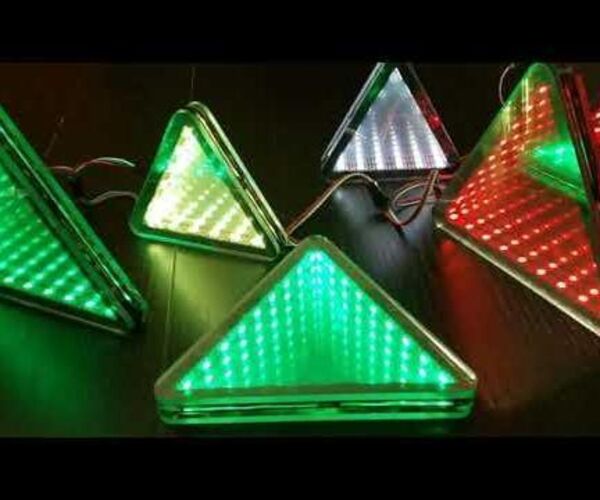
Programmable Infinity Mirror
"Seeing nanoleaf like lights decorating the background of a lot of YouTubers out there, thought that I would try kicking it up a notch by using triangles and making them infinity mirrors. Took inspiration from a number of Instructables as well as many others out there on the Internet, and used the programming code from a previous Instructable of mine (https://www.instructables.com/Totally-Lit-Programmable-RGB-LED-Acrylic-Sign/) where I lit up engraved acrylic with addressable RGB LEDs. Supplies: Addressable RGB LEDs Arduino nano Acrylic (clear) one way mirror film soldering iron connector wires super glue E6000 glue masking tape utility knife" [...]

Development of ClockSquared Mini
"Summer break is here, and with some time to spare I decided to challenge myself with a project that I call “Clocksquared Mini”. It is Clocksquared, but in a tiny wristwatch package. This gives rise to a major challenge, as everything has to be shrunk down approximately ten times from a 300x300x50 mm to an approximately 35x35x7 mm package. Moreover, running everything off a tiny battery whilst maintaining an acceptable battery life also turns out to be quite difficult. I already have made quite some progress that I would like to share. I recently finished designing the main PCB, which is a 2-layer board." [...]
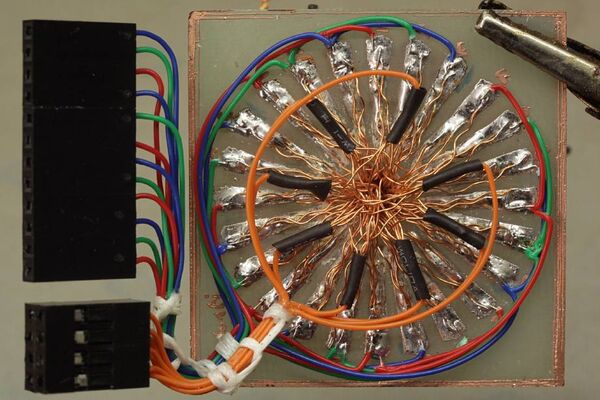
Please Do Not Water This Tree
"About two years ago, I made a little LED tree as a gift. An extremely simple design with 17 white 0603 LEDs soldered to magnet wire, twisted and bent to make branches, and combined them to a small LED bonsai. Electrically, all LEDs are wired in parallel and connected to 4.5 V via an LDR. This lets the tree react to the ambient brightness and helps it to great battery life. In fact, it is still glowing nicely with its first set of batteries! This most basic circuit combines a remarkably natural analogue brightness control with efficient white LEDs, so long battery life isn’t too surprising." [...]
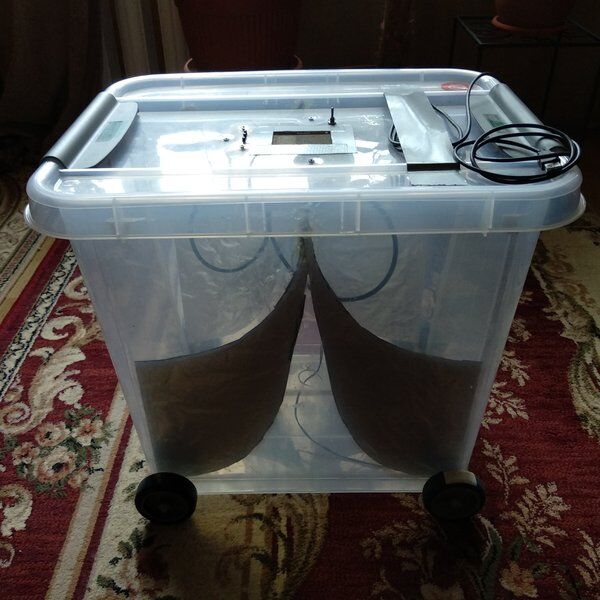
GPRino
"Ground Penetrating Radar using Arduino This project aims the development of a very low cost (under 300 USD components cost) Ground Penetrating Radar. The acquired data can be visualized onboard, in real time, as well as stored and transferred to a PC for further processing. The digital section uses an Arduino Mega 2560 board. The onboard visualization uses an LCD shield for Arduino Mega 2560. The analog section will be custom built. The frequency range is 323 MHz - 910 MHz." [...]

Star Trek Apple Watch Charger Dock
"Do you want a Charger Stand for your Apple Watch that looks like the Desktop Viewer / monitor from the original Star Trek series? I did, I was inspired by several Apple Watch charger stands that looked like various Macintosh Computers. So, after I got a 3D in September, I worked through several simple designs in TinkerCAD and felt like I was ready to tackle something a little more difficult. There may have been easier ways to do what I did, but the "ungrouped" image from TinkerCAD shows the number of objects required to create the monitor section. The tools, software and materials needed for this project are: Ender 3 pro 3D printer (or any 3D printer) Cura (or your favorite slicer) TinkerCAD (I used this as it was free and had a easy learning curve) Gray PLA 1.75 mm filament (any color will do, but the original in the show was a shade of gray) #4 x 3/8" sheet metal cap screw (Phillips head) Phillips screw driver And of course an Apple Watch and charger. " [...]

DIY Retro Look FM Radio with Linear Scale
"Contains a linear scale in which the frequency is displayed with an color LED dot which is an integral part of the WS2812 LED strip. The device presented in the video is a standard FM Arduino radio but with an nice retro look. Contains a linear scale in which the frequency is displayed with an color LED dot which is an integral part of the WS2812 LED strip. There are several ways to select stations: standard with rotary encoder, predefined (memorized) stations in Code and auto dial (seek) function The radio contains the following components: -Arduino Nano microcontroller -Si4703 cheap FM Radio board -WS2812 LED strip with 21 LEDs -Small D-Class audio amplifier board -Speaker -and rotary encoder For the same hardware I will present you two different ways of working which are actually two different codes. In the first case, the stations are selected manually using a rotary encoder which in this case simulates a variable capacitor. Also, in the code, we can redefine known radio station frequencies which we can select then by pressing the rotary encoder switch." [...]
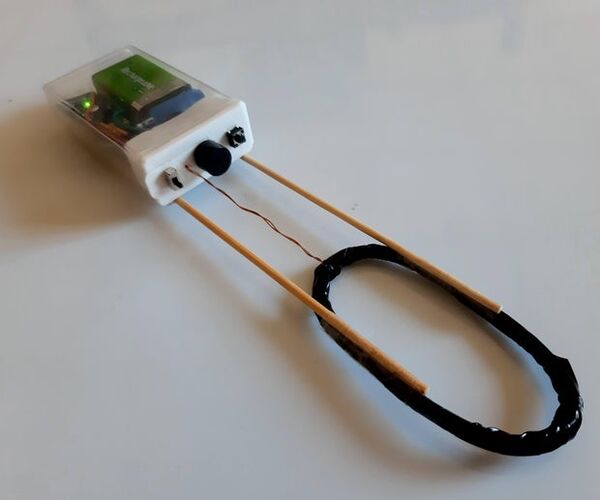
Minimal Arduino Metal Detector
"With an Arduino, 10m of wire and a 100 Ohm resistor you can build a metal detector in 10 minutes! It is based on sound physics and works for a large range of coil sizes and shapes. The sensitivity is not enough for treasure-hunting, but it can be made into a small hand-held device that is very useful indoors to check for the presence of metals. It will help you find nails inside wood or heating pipes in the wall, and to check the composition of tools and furniture. The method can also be used to integrate as a sensor, integrated with more elaborate projects. You will need a coil of at least 20 windings but it works better with 50 or more windings." [...]

Building an RC Feeder Airboat for Fishing
"This is a story about failure and how I managed to iterate on the design process so I can fix my mistakes. For some time now, I wanted to make a boat that I can use on my fishing trips where I can use this boat to pull the fishing line out on the water, beyond what I can cast by throwing and to also serve as a feeder boat to bring in extra food to the cast place for when catching carp. When thinking about the design of the boat, I chose to make an airboat because the lake where I usually go fishing has a lot of grass growing in the shallow water, so any propeller or anything else sticking out of the bottom will become tangled and the boat can get stuck. Below are the two videos of the entire process. The first one is the initial making that at the end did not work as expected but then after fixing the issues, the boat worked perfectly even while carrying a lot of weight. Tools and materials used in the video: A2212 RC Brushless Motor 30A Brushless Motor ESC High power servo 9g servo motor FlySky FS-i6X RC transmitter with FS-i6B receiver 2200 mAH 11.1V Li-po RC battery Li-po low voltage battery alarm RC replacement propellers Utility knife Hot Glue Gun Hot glue sticks Stainless steel ruler Mini drill Machinist square" [...]

How to Make a Tone Control for Amplifier 2.1
"So on my Youtube channel, many people ask how to combine two amplifiers into one. The first amplifier is used for satellite speakers and the second amplifier is used for subwoofer speakers. This amplifier installation configuration can be called Amplifer 2.1. To answer that question, in this article I will create a tone control for the 2.1 amplifier. So this tone control can divide one audio source into 3 outputs. the first and second outputs are for the satellite speaker amplifier and the third output is for the subwoofer speaker amplifier." [...]
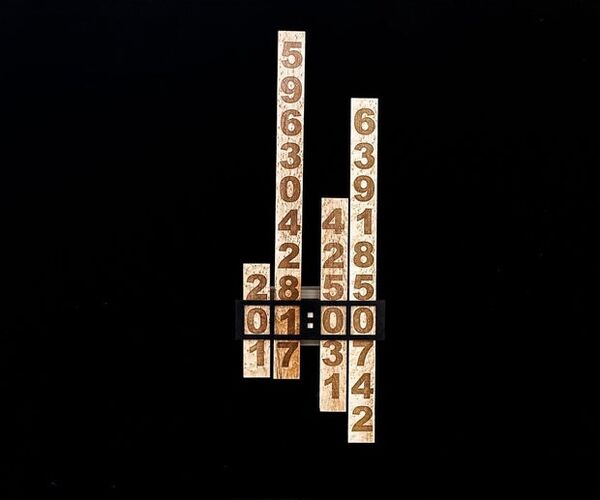
Slide Clock
"I enjoy designing and building interesting clocks and am always looking at unique ways to display the time. This clock uses 4 vertical slides that contain the numbers. Four stepper motors position the slides so that correct time is shown in the display area of the clock. The steppers are controlled using an Arduino Uno with a CNC Shield. It uses an Adafruit PCF8523 RTC board to keep the time. The case and mechanical aspects are all 3D printed and the slides displaying the numbers are made of wood with laser engraved numbers." [...]
Arduino: Continuous MIDI Controller / KeyBoard
"This instructable Making a Continuous type MIDI controller / Keyboard is explained. A very simple concept of capacitive sensing is used along with MIDI communication and sound synthesizer software. You may refer Attached video for a quick demonstration or you may refer half-hour-long video to have a detailed understanding of working. Video on working details: Supplies: Arduino Mega Aluminum Foil 500 kOhm resistor: 48x Header pins for Arduino Soldering Kit" [...]

Mini Gamepad
"Hi friends, I made this tiny little gamepad using ATTINY85 , I wanted to make this for a long time but didn't have enough time , finally finished it and it is so much fun to play with. Firstly I apologize for the clumsy build but I have seen a few people build it on a single sheet of PCB so I wanted to try a different design. Am also no expert at soldering so please bear with me. Supplies:What you would need to build it : 1. A couple of ATTINY85 chips (only a single game fits on each attiny85) 2. PCB (you can use any size and design the gamepad your own way) 3." [...]
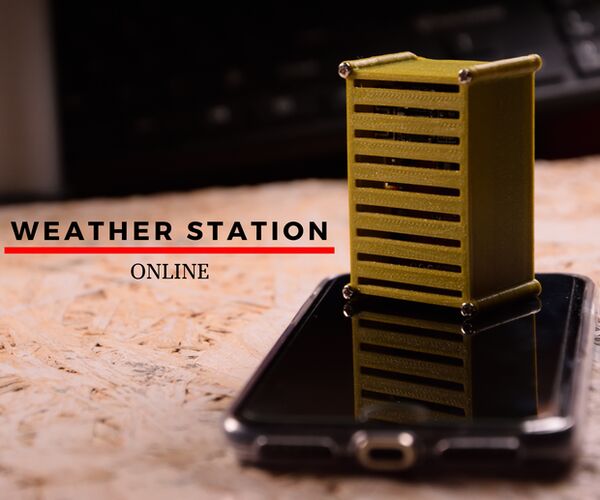
Online Weather Station
"You will not believe it! But from the beginning. I was working on the next version of CoolPhone and the number of errors I made when designed it forced me to take a break from it. I put my shoes on and went outside. It turned out to be cold so I went back for a hoodie. "A walk in the fresh air will do me good" - I thought, not knowing what awaited me." [...]
Neopixel RGB LED Sword Prop
"Hi everyone, today I'm going to show you how to make a fantasy sword that glows using embedded Neopixel style LEDs. I must admit that I did not really have a reason for making this, other than I just felt like having a glowing sword. I'm a big ol' nerd okay. Anyway, hopefully someone else finds this useful as a part of a costume or prop. The sword is about 33 inches (~84cm) long, so it should comfortably work as a one-handed sword for adults, or a two-handed sword for children. I should note, that, due to the electronics, the grip is slightly thicker than you might expect." [...]
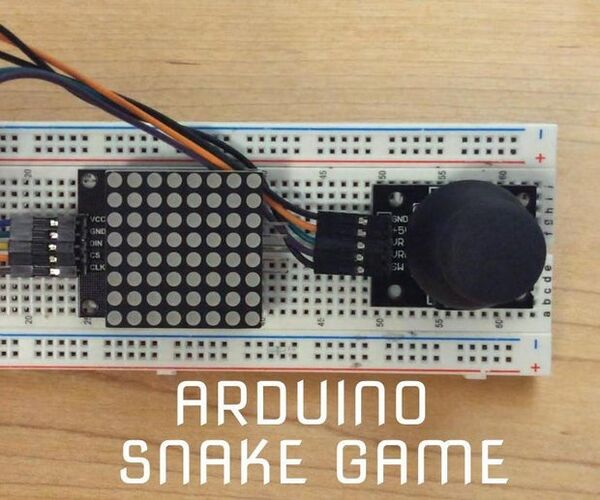
Arduino Snake Game
"By using the Maxx7219 and a Joystick module you can make a fully functioning snake game Supplies: - 1 Arduino Nano/Uno/Mega/Due - 1 Maxx7219 - 1 Joystick Module" [...]

A Simple Stand for an Acoustic Levitator MiniLev
"This project would not be possible with the amazing project that Dr. Asier Marzo created. https://www.instructables.com/Acoustic-Levitator/ Like all good projects, this one started out simple and grew as time went on. After reading Dr. Marzo intractable and realizing that there were a couple of old HC-SRO4's laying around left over from a robotics project, we decided to build one. Several things were obvious looking at the pictures of the dual transducer design (MiniLev) and reading articles. First, if the transducers are held parallel to each other, you have a better chance of creating a consistent standing wave. Second, the distance between the transducer needs to be adjustable, while holding the transducers parallel." [...]
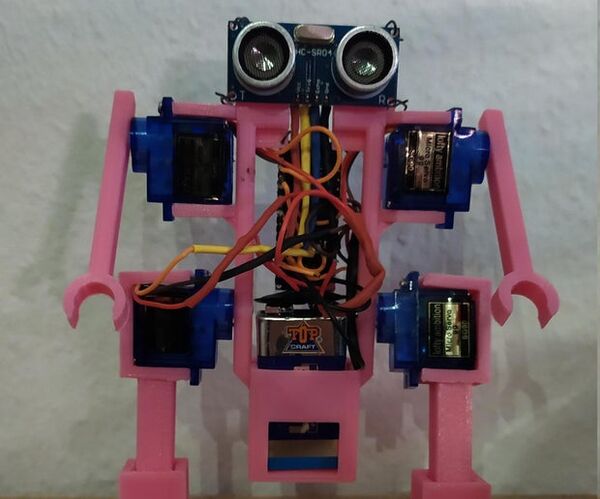
Edu-Nano-Bot
"I made a simple robot with basic functions that can be used to teach kids how to code and many more. The robot is pretty inexpensive can can be made with a budged of about 10. Its my first robot so far and I will show you what you can do with him and how to build him.His main features are: Easy to buildInexpensiveCan move his arms and legsHe is able to move forwardHe can sens if anything is in front of him and react on itHis parts are relative fast to print (compared to other robot-projects you can find) Supplies: 4x SG90 Servo 1x HC-SR04 Ultrasonic sensor 1x Arduino nano 1x 9V Battery 1x 9V Battery cable/connector 1x Switch 3D-Printer PLA of your choice Hot iron Tin-solder Shrinking tubes Wire (Breadboard)" [...]

Portable Disco V2 -Sound Controlled LED's
"I've come a long way with my electronics journey since I made my first portable disco. In the original build I hacked together a circuit on prototype board and managed to build a neat, little pocket disco. This time around I designed my own PCB and worked out a way to have the LED's dance with either a mic or directly from a music source. Having the LED's dance to a direct music source was an afterthought so the board for that I had to use prototype board. However, I did design one in eagle which I have made it available in the Instructable. Version 3 will be even bigger and I'm hoping to incorporate bluetooth as well." [...]

Cycloidal Disk Electro Mechanical Timer.
"Cycloidal Disk Electro Mechanical Timer is a mechanism I designed to control the start and stop of some of my automaton designs. When the user presses the start button, the automaton will start, cycle through the presentation, then stop automatically using this mechanism. I wrote a Python script for the Autodesk Fusion 360 "Add-Ins" menu in order to generate a hypocycloidal "sketch" curve based on pin count and pin diameter. From this curve I can easily create a cycloidal disk and plate. Thus the Python script allows me to easily adjust the input to output ratio and size of the cycloidal mechanism in order to synchronize the running time of an automaton with its presentation, all within a much smaller space than before. For this mechanism, I designed the cycloidal disk and plate for a ten to one input to output ratio, meaning the large gear will turn ten times before the cycloidal disk turns one time, at which point the mechanism stops." [...]
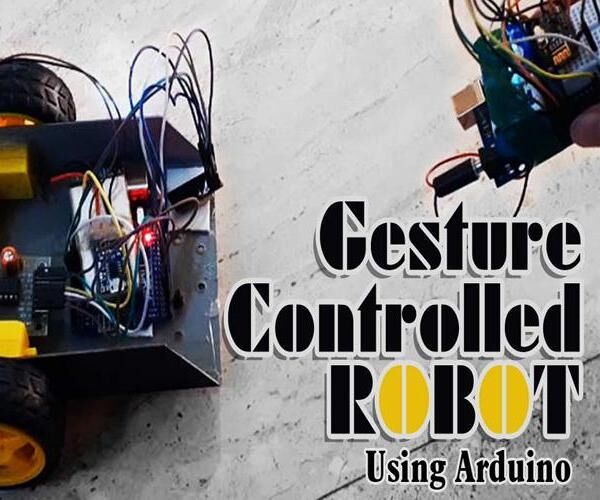
Gesture Controlled Robot Using Arduino
"Robots are used in many sectors like construction, military, manufacturing, assembling, etc. Robots can be autonomous or semi-autonomous. Autonomous robots do not require any human intervention and can act on their own according to the situation. Semi-autonomous robots work according to instructions given by humans. These semi-autonomous can be controlled by remote, phone, gestures, etc. We previously built few IoT based robots, which can be controlled from the webserver." [...]

AM/FM/SW Radio Receiver - Si4730 / Si4735
"DIY AM/FM/SW/ DSP radio receiver, using Arduino Uno/Nano and a color display TFT ST7735 1.8in. This is my design of a AM / FM / SW radio receiver with DSP technology. Features: This Arduino radio receiver has an attractive look and nice features using an inexpensive color TFT / Arduino and fell componets. It includes the indication of the frequency in large numbers in the style of vintage seven segments, two bargraphs for indicating the signal strength, selection of 7 BW filters for AM, indication of the wavelength of the band, 2 color themes, Stereo/Mono indication and 14 bands for coverage of LW / MW / SW / CB, ranging from 100kHz to 30MHz and the commercial 64-108MHz FM band. I wrote this code (sketch) in a simple way, allowing beginners (and advanced) to make their own modifications and customize the radio according to their needs. I used the Arduino Uno (Nano or even the Pro Mini) to control the Si4730-D60 integrated circuit (see notes below)." [...]

M5Stack MULTI-TOOL
"M5Stack Multi-Tool has Distances measurement, Spirit level, Voltage sensor, Find my phone, Torch, Home automation controls" [...]
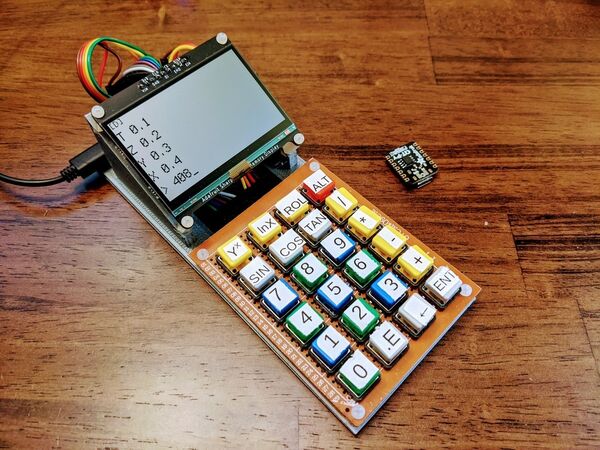
DIY Desktop Calculator with CircuitPython
"In this project, you'll build your own Desktop Calculator with CircuitPython. Along the way you'll also learn about the alternative "RPN" notation for calculating, how a keyboard matrix works (and how to create your own! ), and more! What is "RPN", anyway? Most of us are accustomed to standard mathematical notation, like 2+3*7 or (2+3)*7. Because most operations (like "+") appear between the two things operated on (like 2 and 3), this is called "infix" notation." [...]

IoT Air Quality Sensor with Adafruit IO
"Breathe easy, knowing that you can track and sense the quality of the air (and environment!) around you with an IoT Air Quality Sensor. This sensor measures PM2.5 (particles that are 2.5 microns or smaller in diameter) dust concentrations, temperature and humidity. This sensor is small, wall-mountable (indoors or outdoors), weatherproof, and only requires a WiFi network connection and an AC outlet. You'll assemble an open source air quality sensor. Then, you'll program the sensor using CircuitPython to measure air quality data and periodically send measurements to Adafruit IO, our incredible IoT Service." [...]
That's all Folks!



